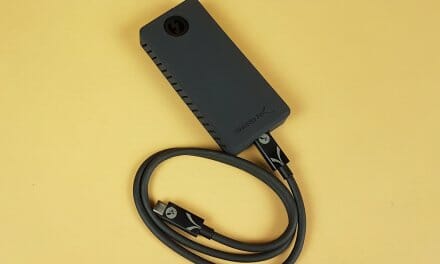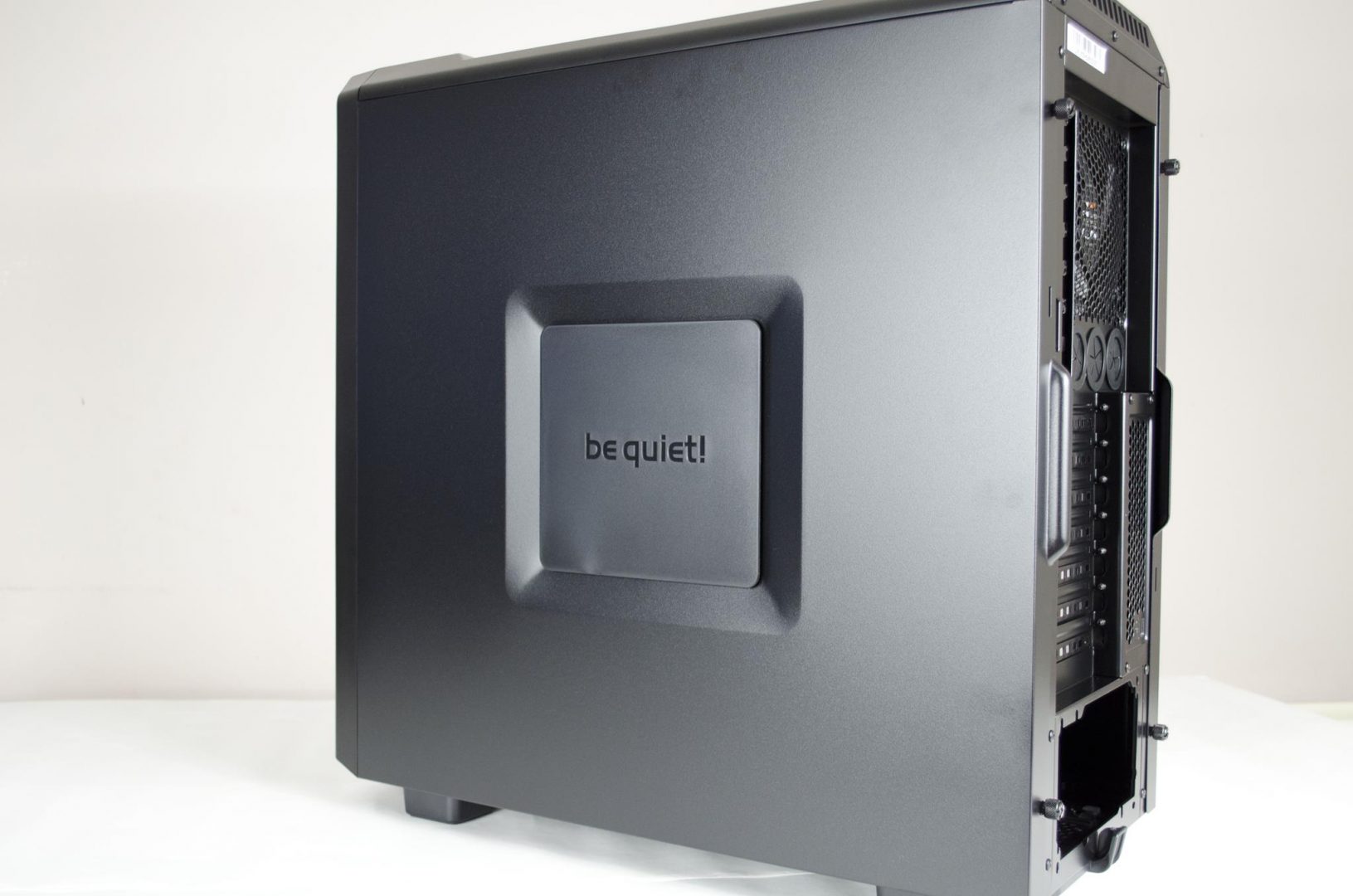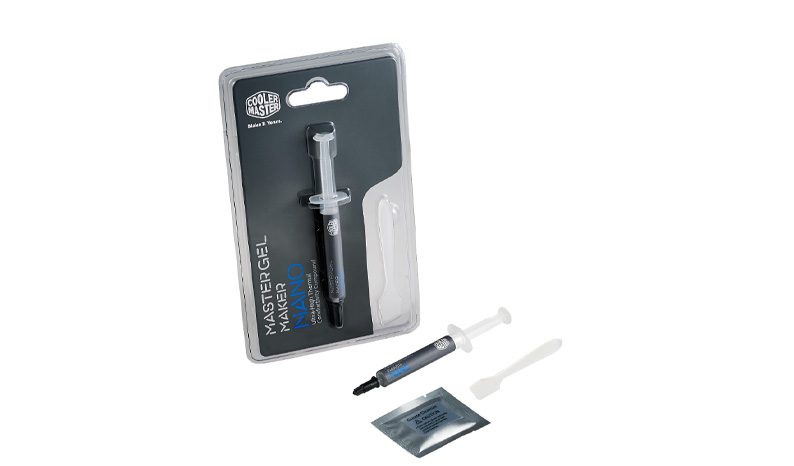
ARCTIC Liquid Freezer III 280 Black ARGB Review
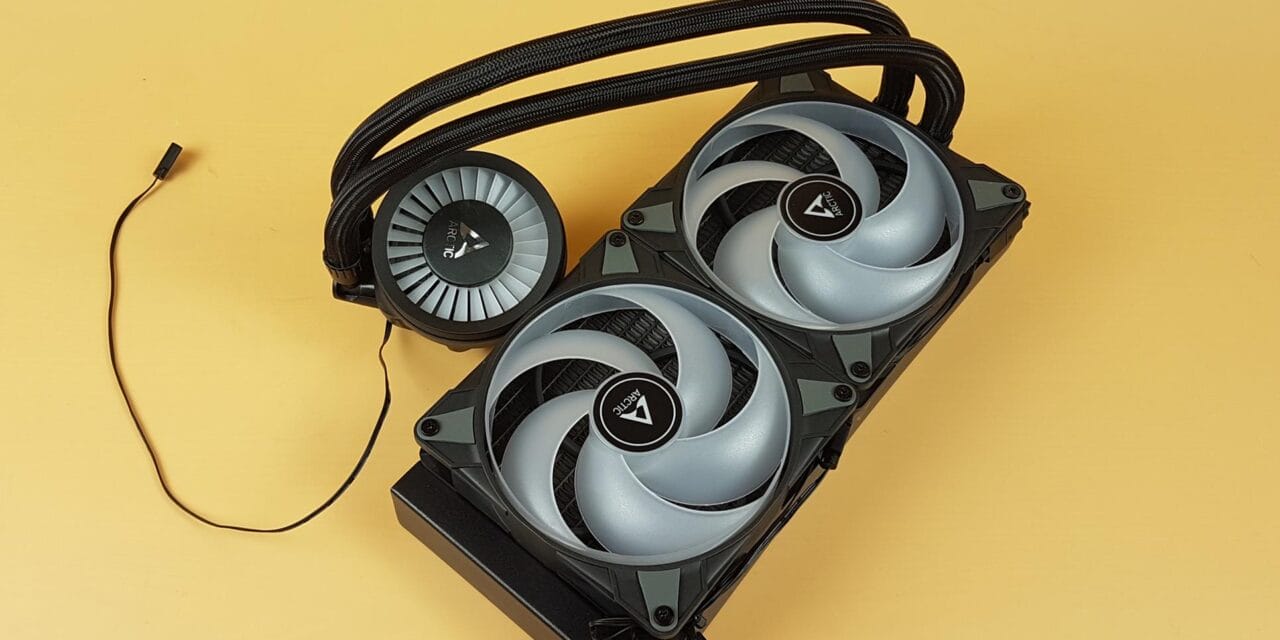
I have tested Liquid Freezer III 240 and 360 versions. The 240mm has performed quite well but I was not satisfied with the performance level of the LF III 360mm version. This time I am taking a look at the ARCTIC Liquid Freezer III 280 Black ARGB.
This cooler is available in black ARGB, white ARGB, and only black options. The new generation of Liquid Freezer coolers takes on the predecessors with fine refinements, a new pump design, a dense fin layout, a removable top pump cover, and finally an option to regulate the speed of VRM fan, Pump, and radiator fans separately as well jointly.
As I mentioned in the previous articles these coolers are only compatible with Intel LGA1700 and 1851 sockets due to the use of a contact frame. It is also compatible with AMD AM4/AM5 sockets. So, this is not good news for those who are on non-supported brackets including LGA1200.
ARCTIC is giving a massive discount on these coolers on the eve of 23 years of celebration. The current pricing would affect the comparison with the competition which would be different once the original prices are restored.
Price:
| Webshop* | |
| Liquid Freezer III 240 (Black) | 103,99 61,35 € |
| Liquid Freezer III 280 (Black) | 113,99 68,39 € |
| Liquid Freezer III 360 (Black) | 118,99 76,15 € |
| Liquid Freezer III 420 (Black) | 123,99 81,83 € |
| Liquid Freezer III 240 A-RGB (Black) | 113,99 69,53 € |
| Liquid Freezer III 280 A-RGB (Black) | 123,99 81,83 € |
| Liquid Freezer III 360 A-RGB (Black) | 133,99 88,43 € |
| Liquid Freezer III 420 A-RGB (Black) | 143,99 95,03 € |
| Liquid Freezer III 240 A-RGB (White) | 115,99 71,91 € |
| Liquid Freezer III 280 A-RGB (White) | 125,99 83,15 € |
| Liquid Freezer III 360 A-RGB (White) | 136,99 89,04 € |
| Liquid Freezer III 420 A-RGB (White) | 149,99 97,49 € |
* 5.99 € shipping costs within Europe
The prices are taken at the time of the review.
Specifications
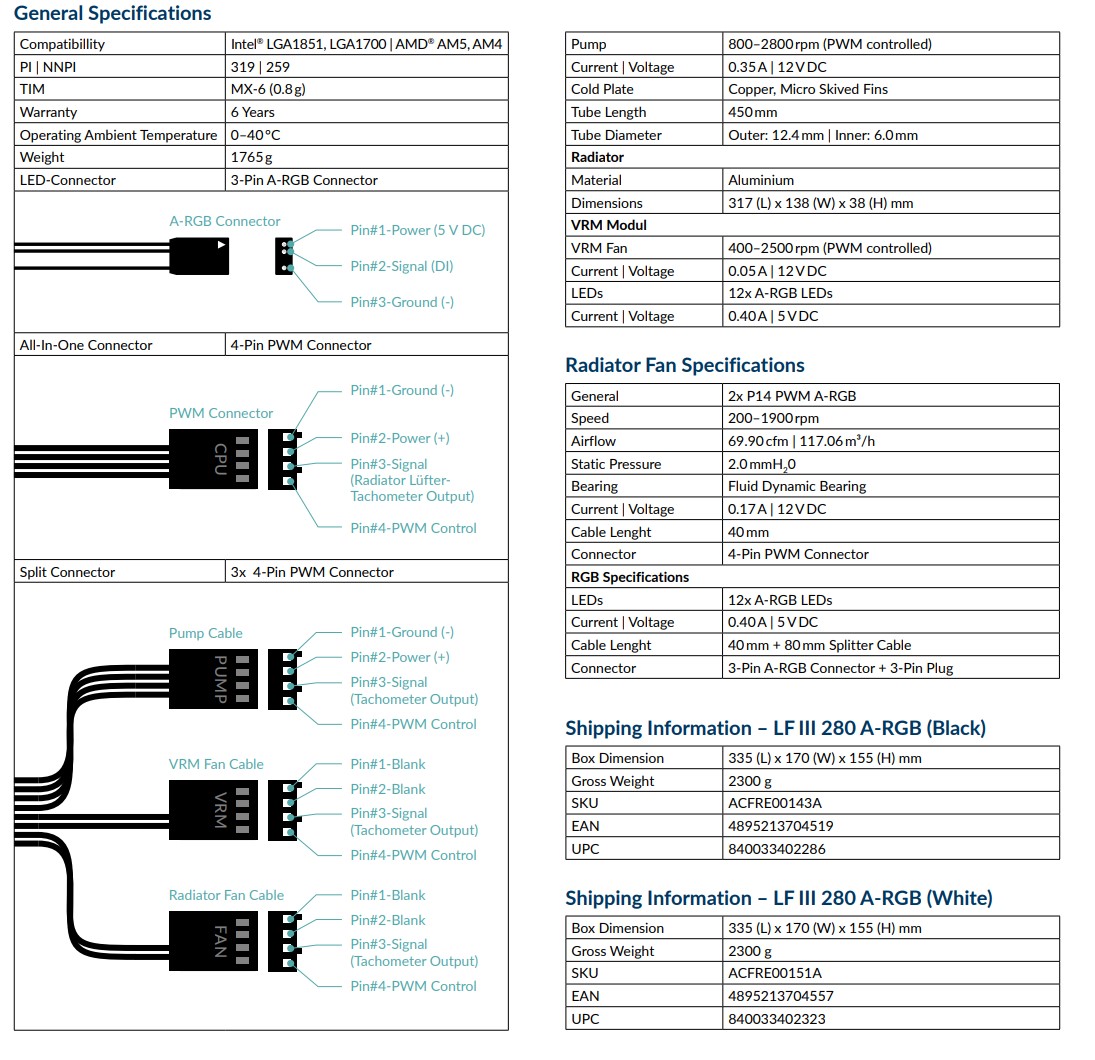
ARCTIC is providing a 6-year warranty on this cooler and it comes with 0.8gm of MX-6 thermal paste which is their top-performing thermal paste as of now. The 280mm and 420mm versions are provided with P14 fans. Our sample has P14 PWM PST ARGB fans.
Packing and Unboxing
The cooler is shipped inside a slim footprint-cardboard box. The complete packing box is black reflecting the black color cooler inside.
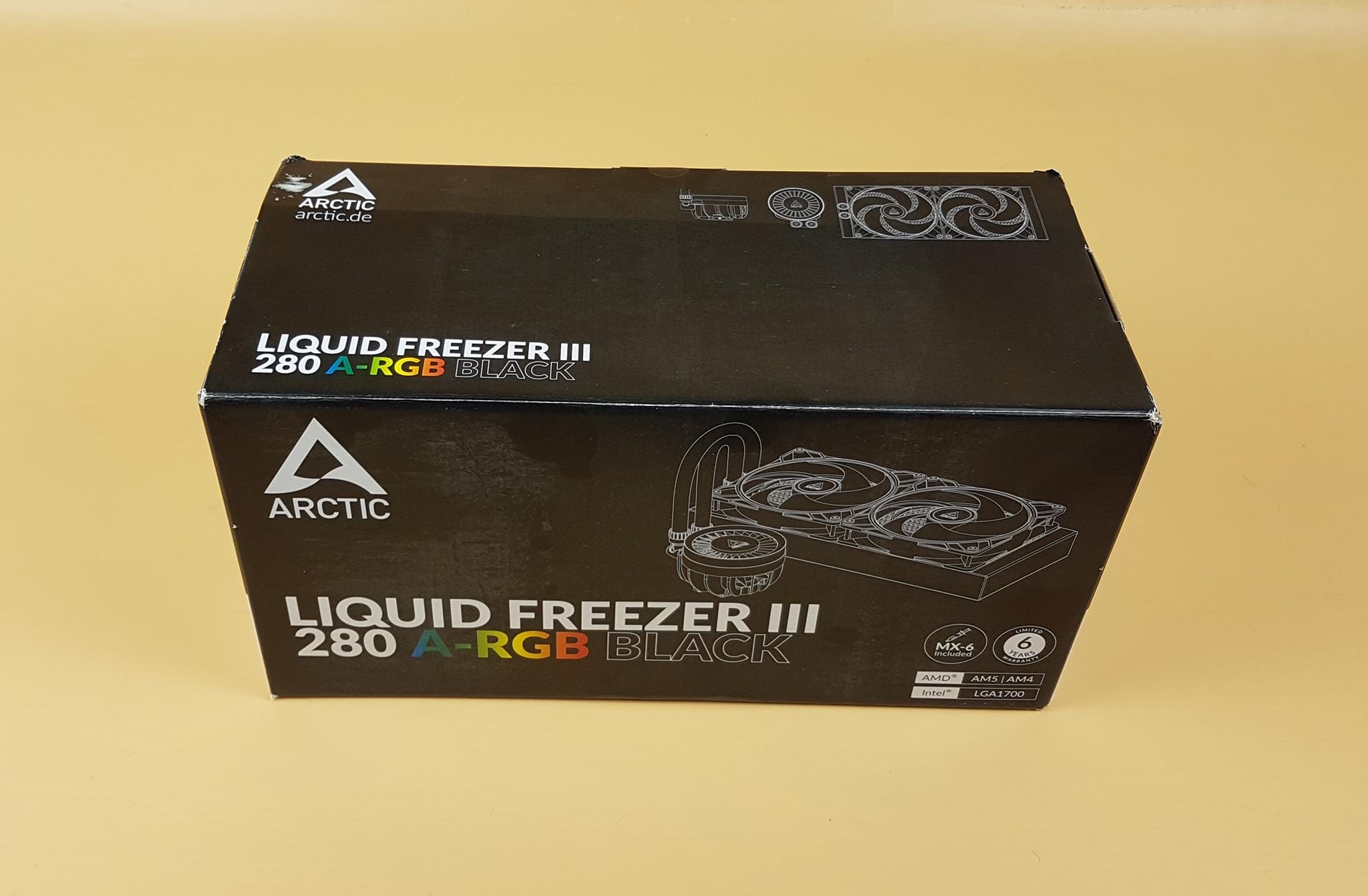
ARCTIC has listed salient features of the cooler at prominent places that include:
- Socket Compatibility
- 6-Year Warranty
- MX-6 Thermal Paste
- Dimension and Specifications of the Cooler
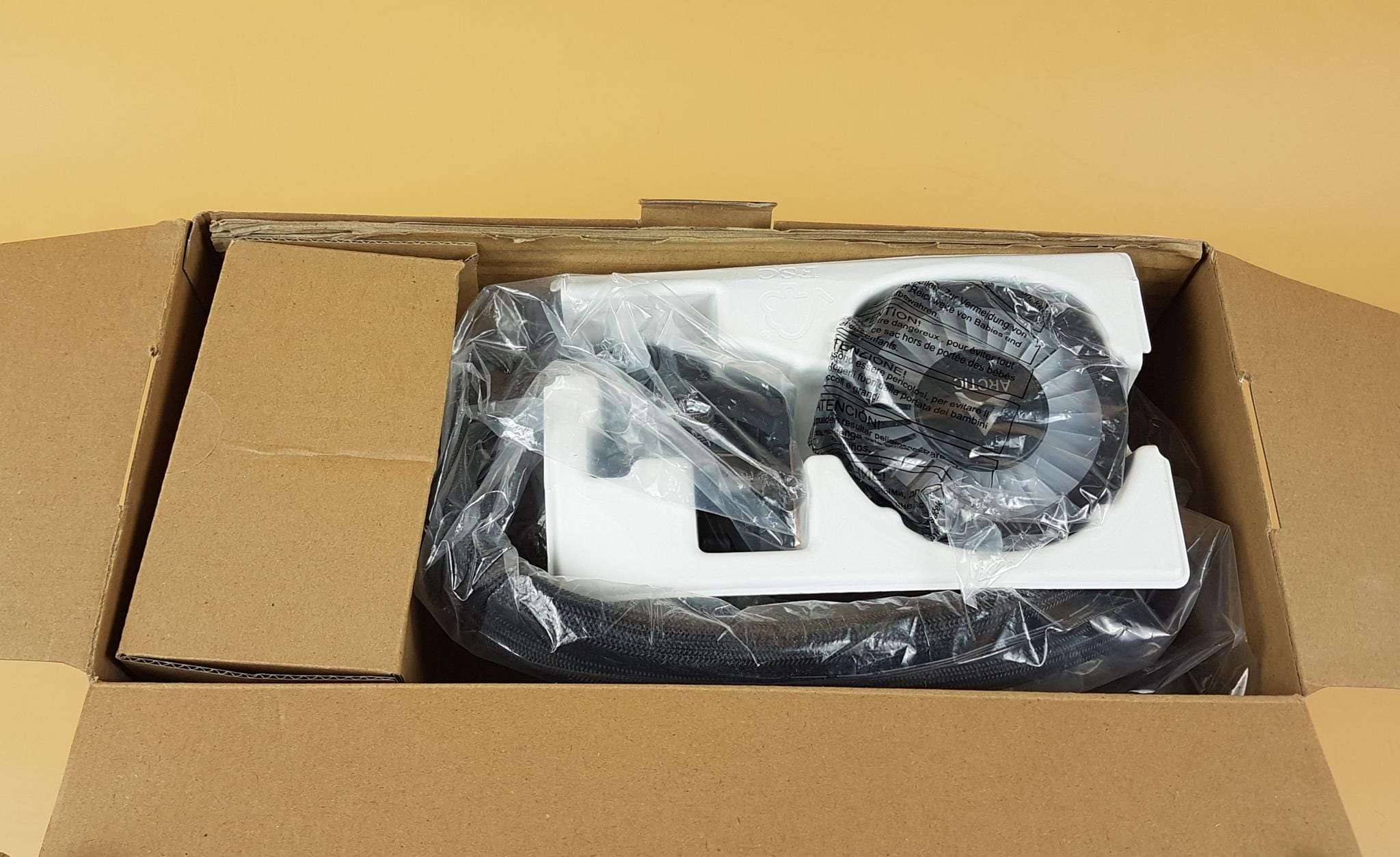
The inside of the packing box is no different than the Liquid Freezer II series of coolers. The pump block and its top cover are placed inside a separate container. There are two accessory boxes. One has a contact frame whereas the other has mounting hardware.
Accessories
Let’s take a look at what is provided in the box. As I mentioned in the previous article, there is no printed user manual so you need an active internet connection for the online manual.
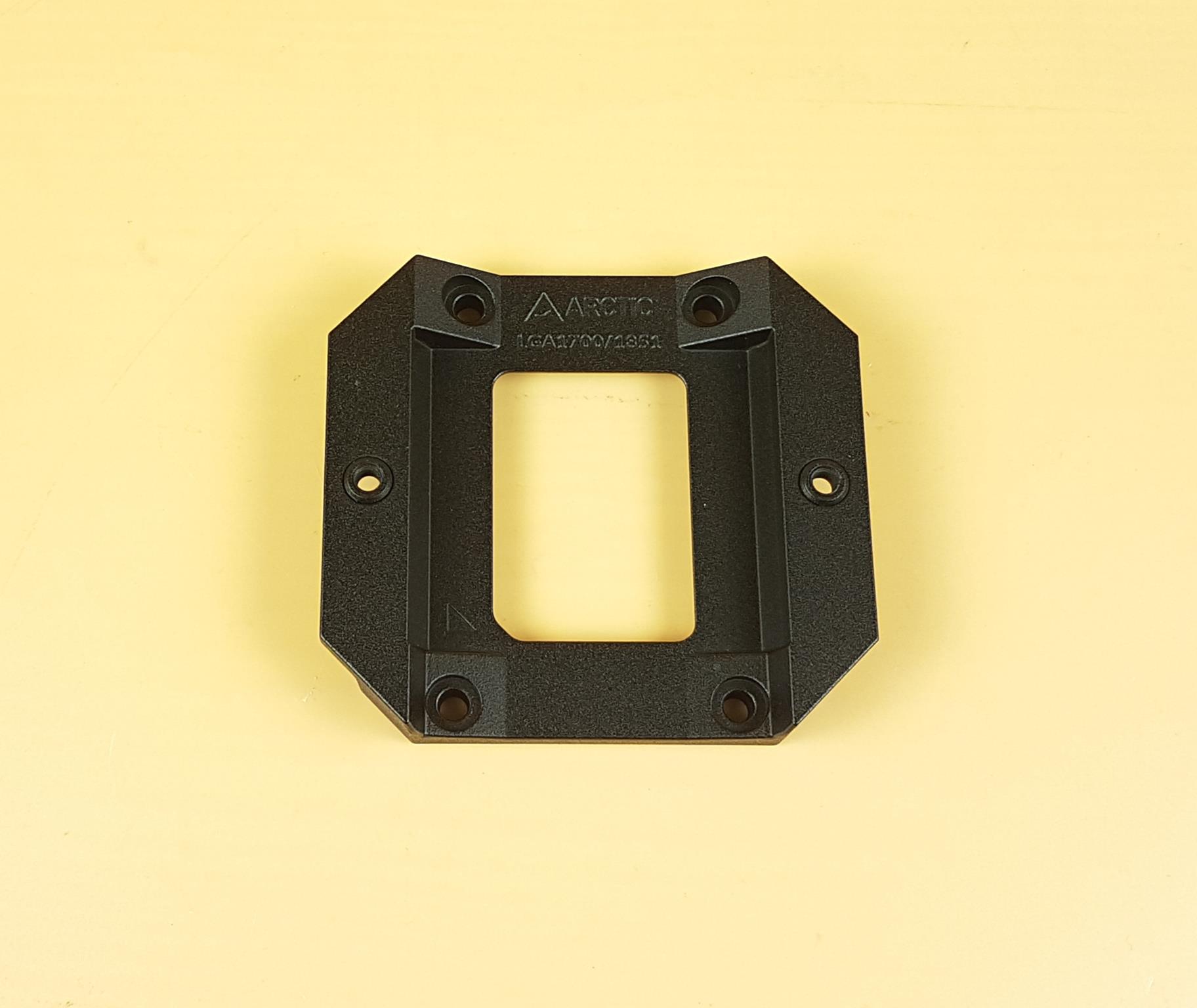
ARCTIC has provided an LGA Contact Frame which is compulsory for the installation. In my opinion, this should be optional and ARCTIC should provide standard mounting hardware as well. This would allow them to provide backward compatibility with other Intel LGA sockets.
Anyhow, ARCTIC has addressed the Intel ILM issue whereby the two-point contact from the Intel ILM can deform the CPU from two sides. This could result in PCB bending as well as improper contact between the cold plate of the cooler and CPU IHS.
This contact frame will work on Intel LGA 1700 and 1851 sockets. This is the reason why this cooler is not compatible with other Intel sockets.
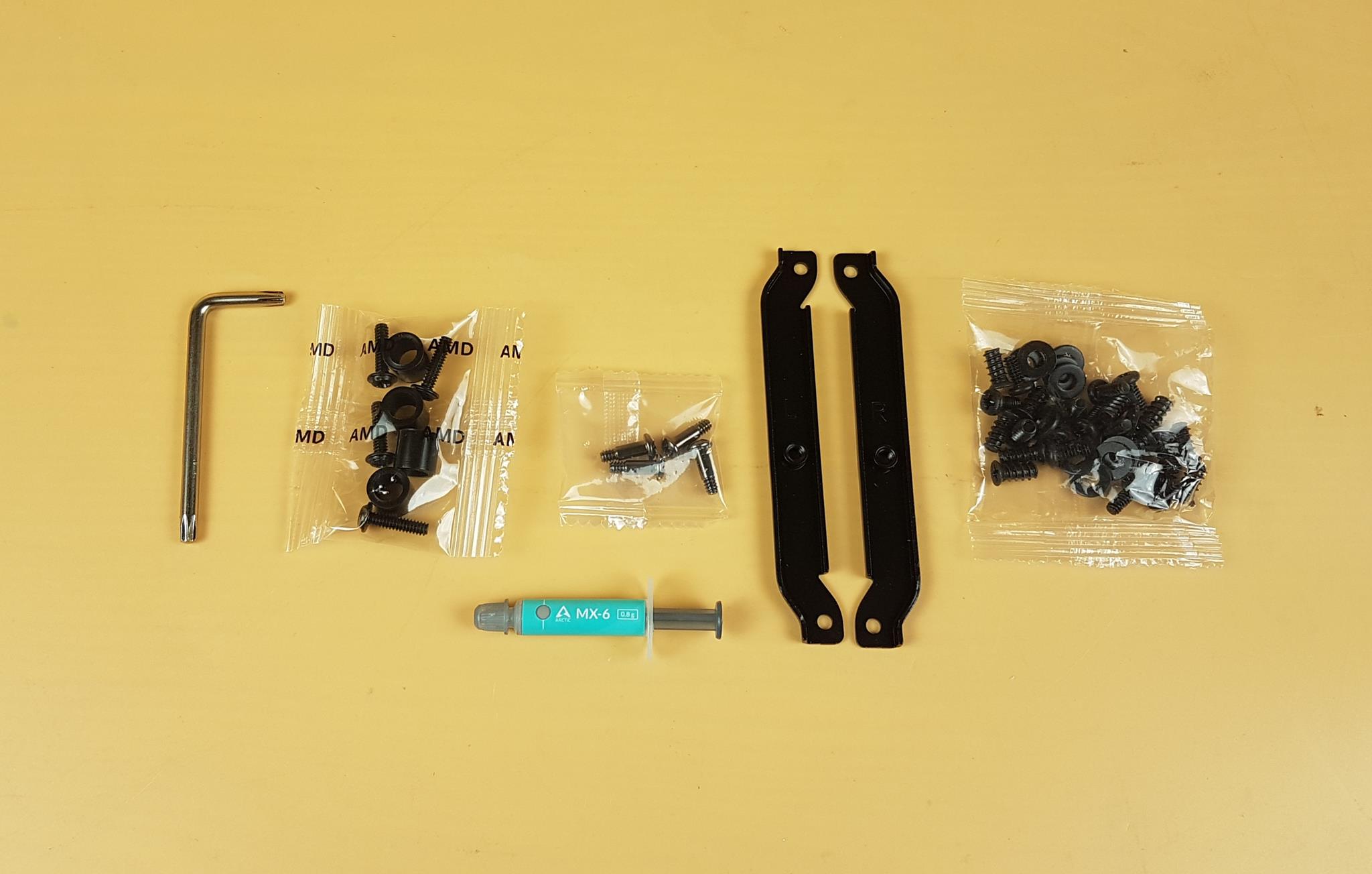
ARCTIC has supplied:
- 1x Set of 2x AMD Mounting Brackets
- 1x Set of 4x AMD Black Spacers
- 1x Set of 4x AMD Screws
- 1x Set of 4x Intel Contact Frame Screws
- 1x Set of 8x Philips Screws and Washers for the Radiator
- 1x Allen Key
- 1x tube of MX-6 thermal paste
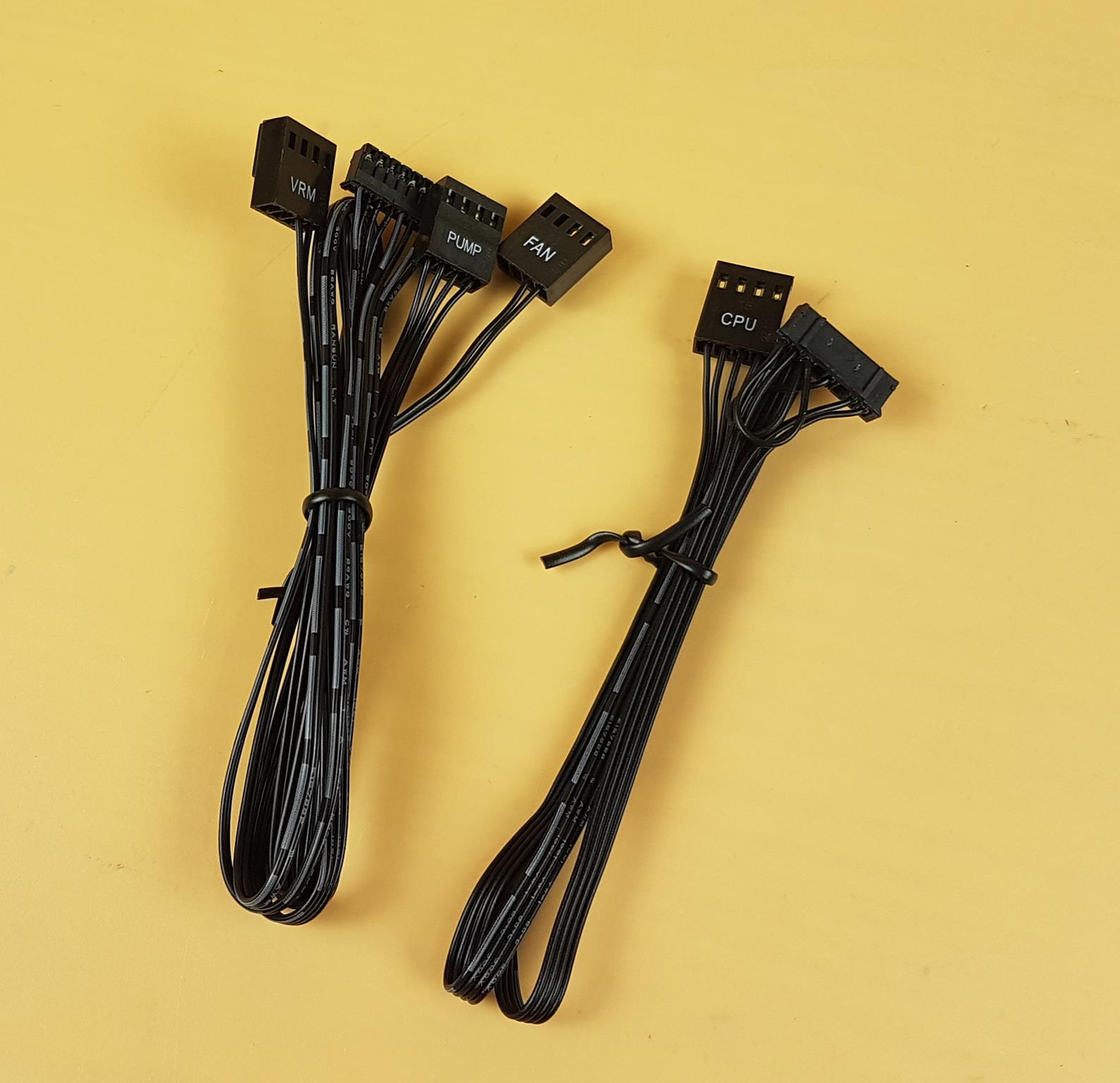
ARCTIC has addressed the reported feedback of no separate control over the radiator fans in the Liquid Freezer II coolers. They have provided two different cables. One cable has the following connectors:
- VRM Fan PWM Connector
- Radiator Fans PWM Connector
- Pump PWM Connector
This cable will allow you to control all these elements separately. However, you would need three 4-pin PWM headers on your motherboard.
The other cable has a single 4-pin PWM connector labeled CPU. Using this cable, all three elements will be controlled from a single source. This is like running a Liquid Freezer III cooler on the Liquid Freezer II basic single cable connection design.
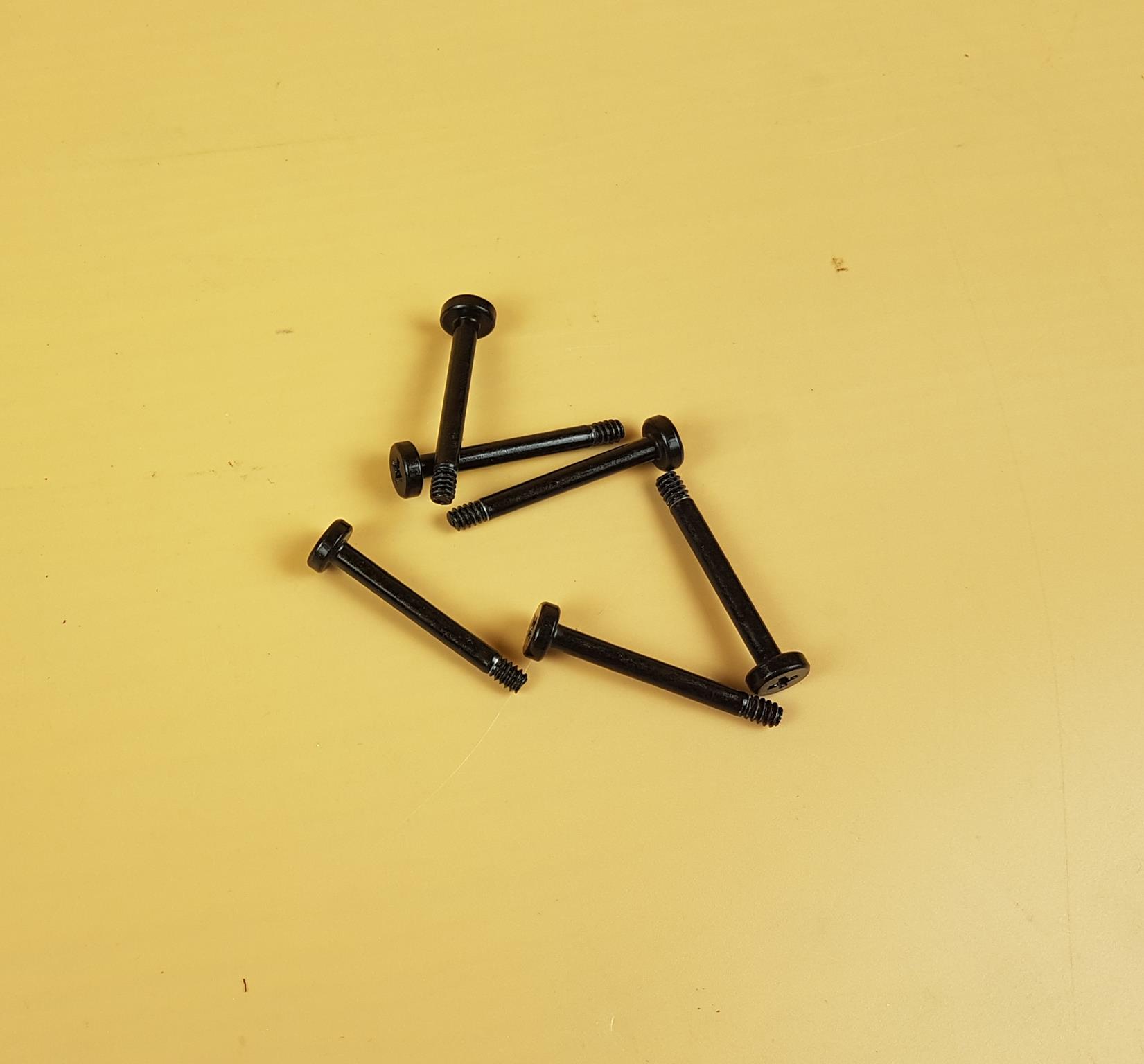
I have removed the fans from the radiator to show the fan screws.
Closer Look
It is time to take a closer look at the components starting with the radiator itself.
RADIATOR
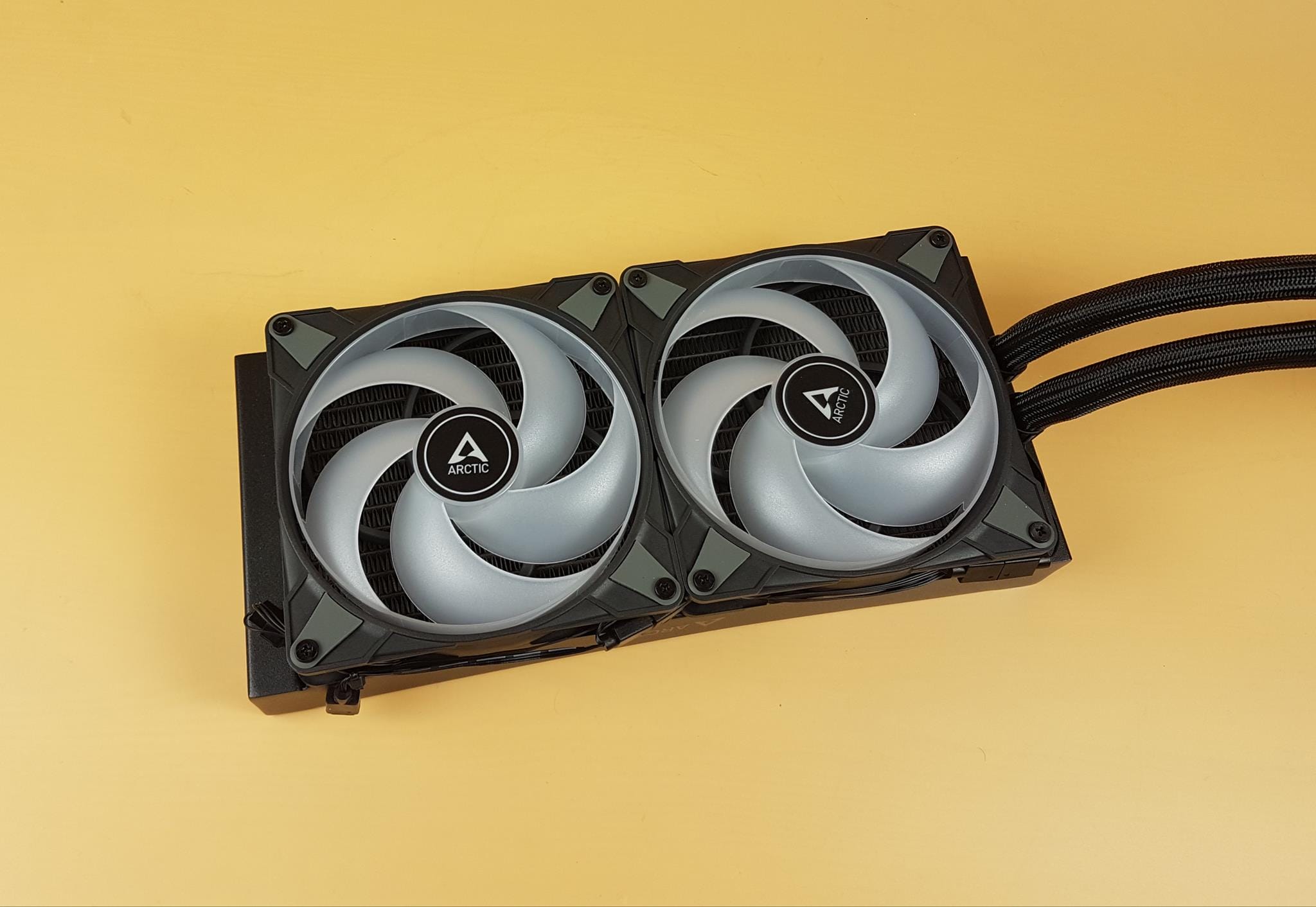
The 2x P14 black ARGB fans come pre-installed on the radiator. I think ARCTIC is probably the first company that started shipping pre-installed fans. As of late, I am seeing many other brands catching up with this trend.
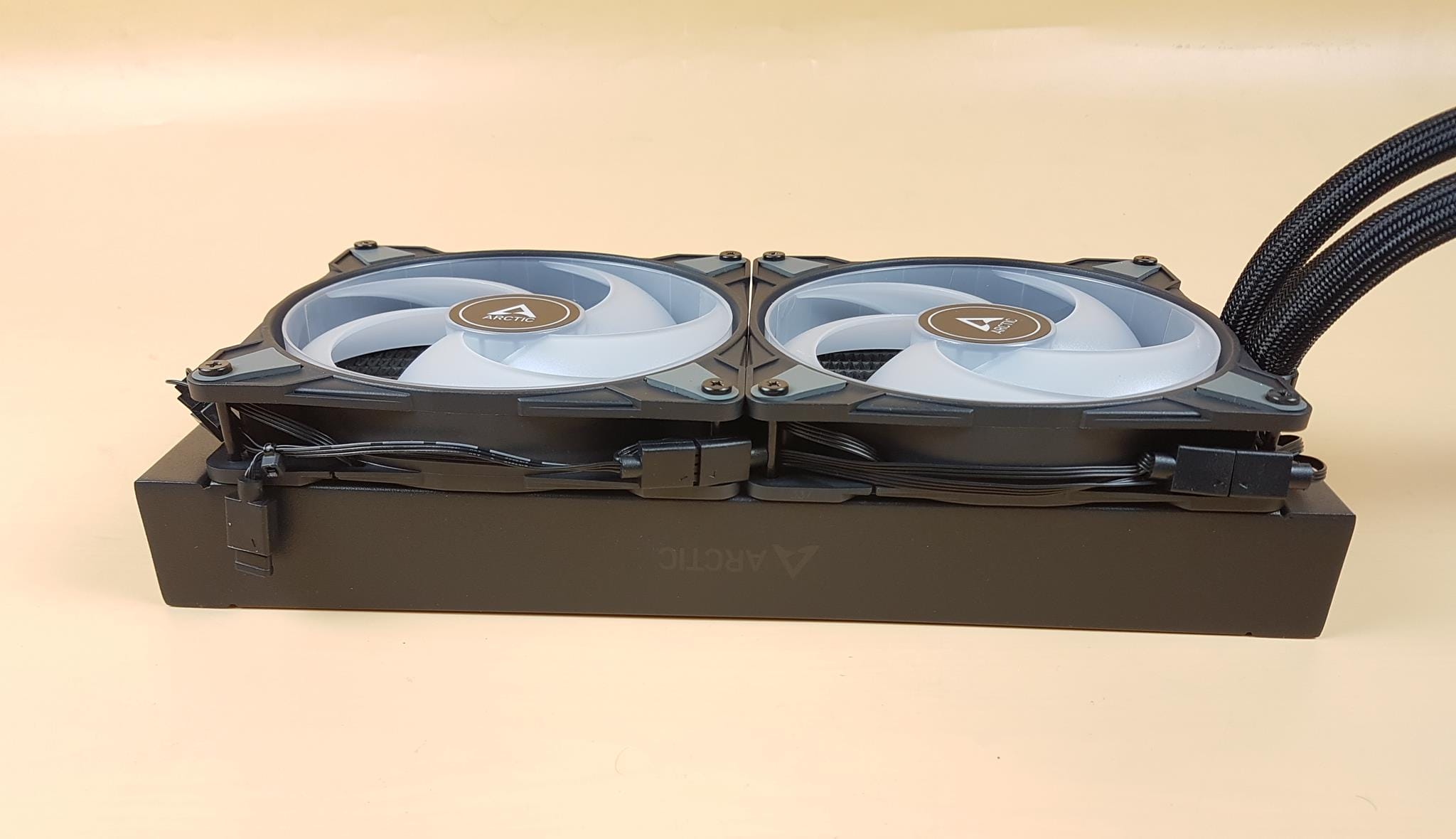
There are two cables per fan. One is the ARGB cable and the other PWM power cable. These are cut short because ARCTIC has done the integrated cable management from the factory. The fans are daisy-chained and the integrated cables are routed on the side frame. There is a 2-way PWM splitter cable and a 2-way ARGB splitter cable coming out from the tube mesh sleeve. Fans’ cables are connected to these splitter cables.
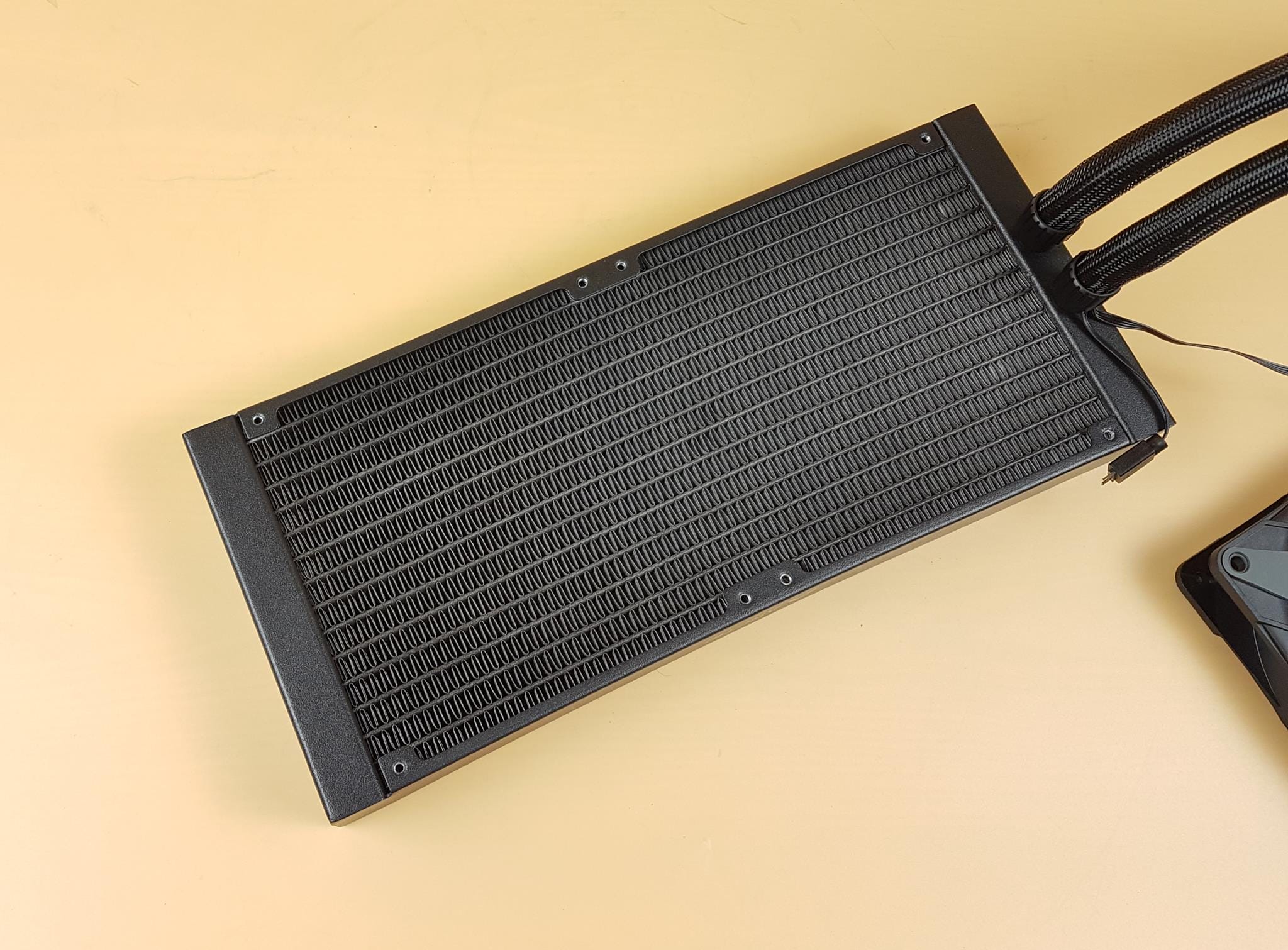
I have removed the fans to show this picture of the radiator. The radiator is made of aluminum material. The dimension of this radiator is 317x138x38mm (LxWxH). However, take note that pre-installed fans would make the overall height 65.5mm.
The FPI count on this radiator is 15. This would mean we don’t need high static pressure fans since there is less resistance to airflow. There is a 23% more surface area on these new radiators as well. The complete assembly is black and we have a 105mm gap between any two opposite end fan mounting holes. The coolant flow channel count is 14.
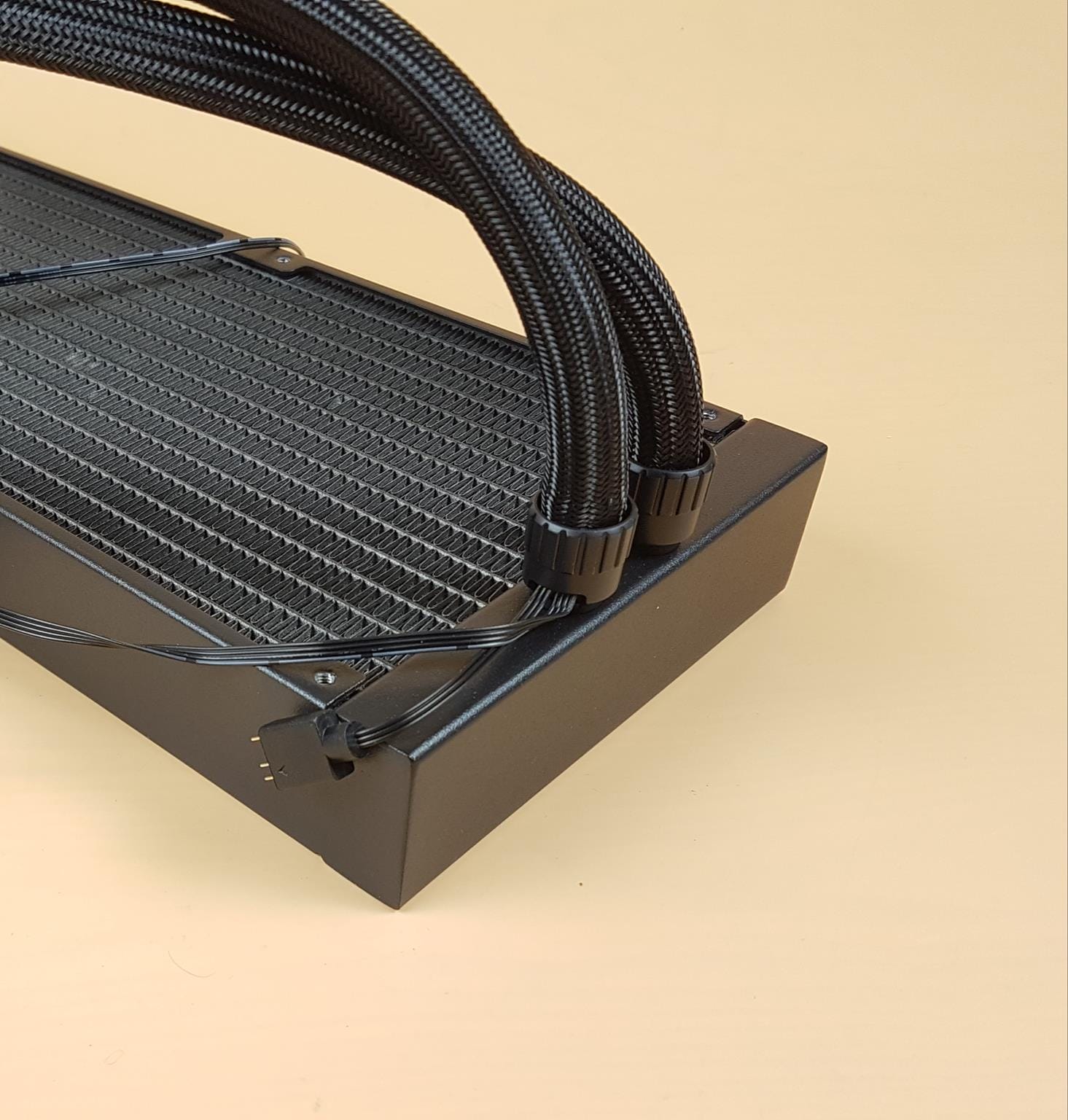
Now, I am showing the tube side of the radiator. There is not much of a difference compared to the 240mm radiator. The connections are still almost in the center and ARCTIC has used stylish clamps. Two cables come out from the left tube. These are PWM and ARGTB splitter cables.
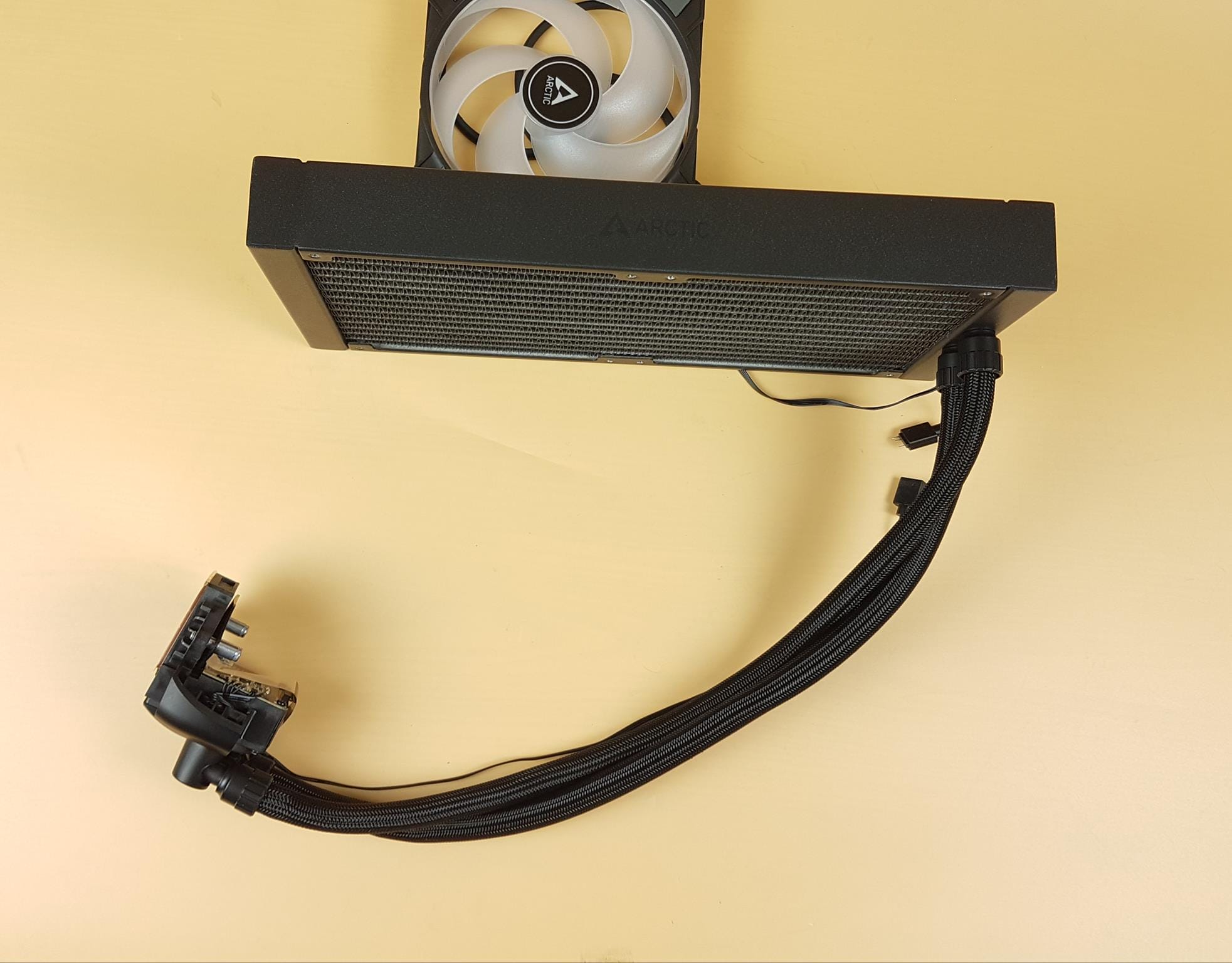
Looking at the side view of this unit you can see an ARCTIC branding on the side frame of the radiator. The rubber tubes have a length of 450mm and they have a black sleeve over them. The ID/OD of these tubes is similar to LF-II coolers i.e. 6.0/12.4mm and they are rubber tubes that have black sleeves.
Pump/Block
ARCTIC has gone back to the drawing board and revamped the block design including the pump and cold plate.
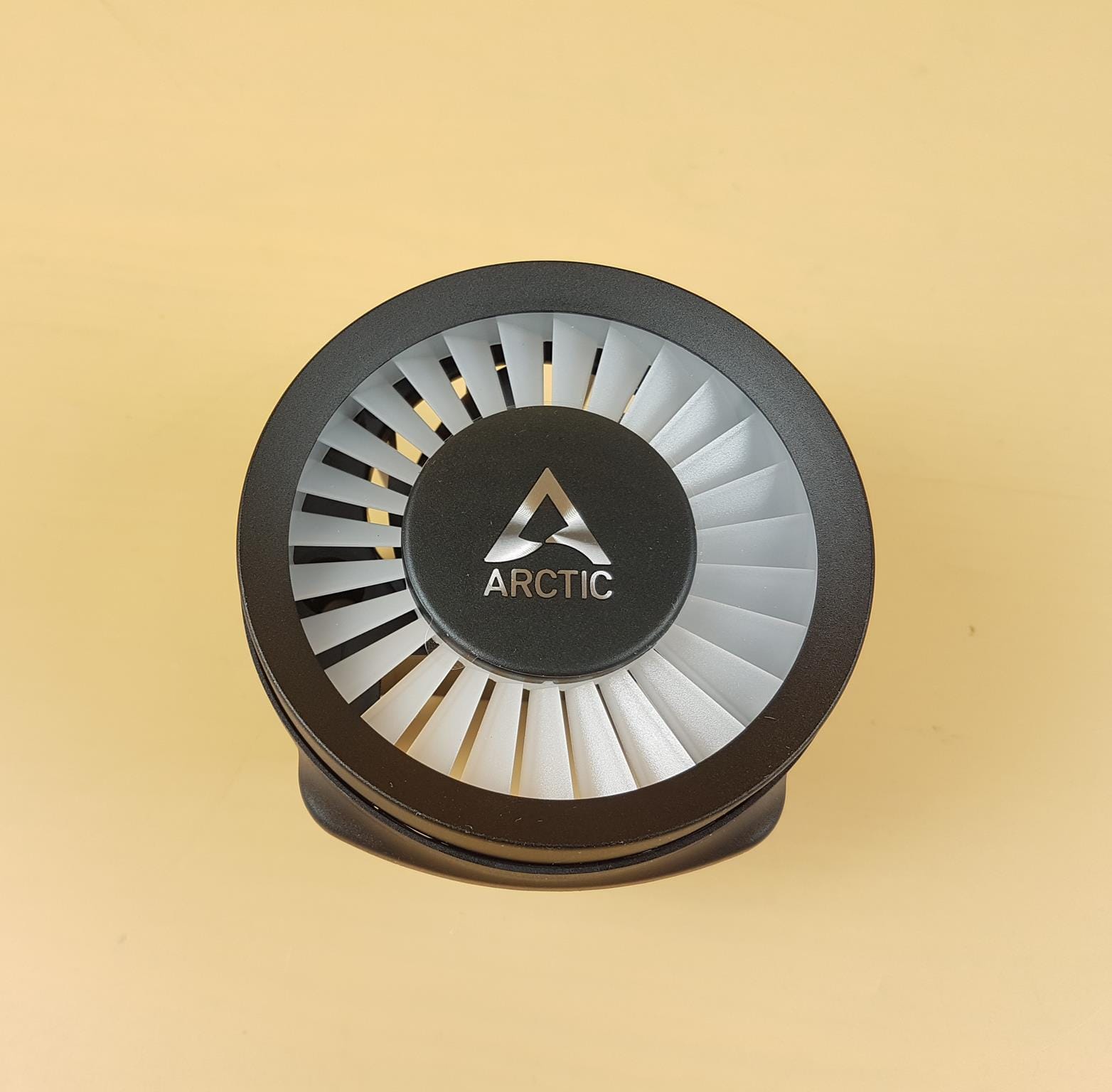
This cooler has a removable pump cover that has an embedded 60mm fan for VRM cooling. There are fin-design guided vanes over the top that provide air inflow for the fan. There are 12x ARGB LEDs under the top for vivid illumination. The fan is rated for 400 to 2500 RPM using 0.05A at 12VDC. The ARGB LEDs are rated for 0.40A at 5VDC.
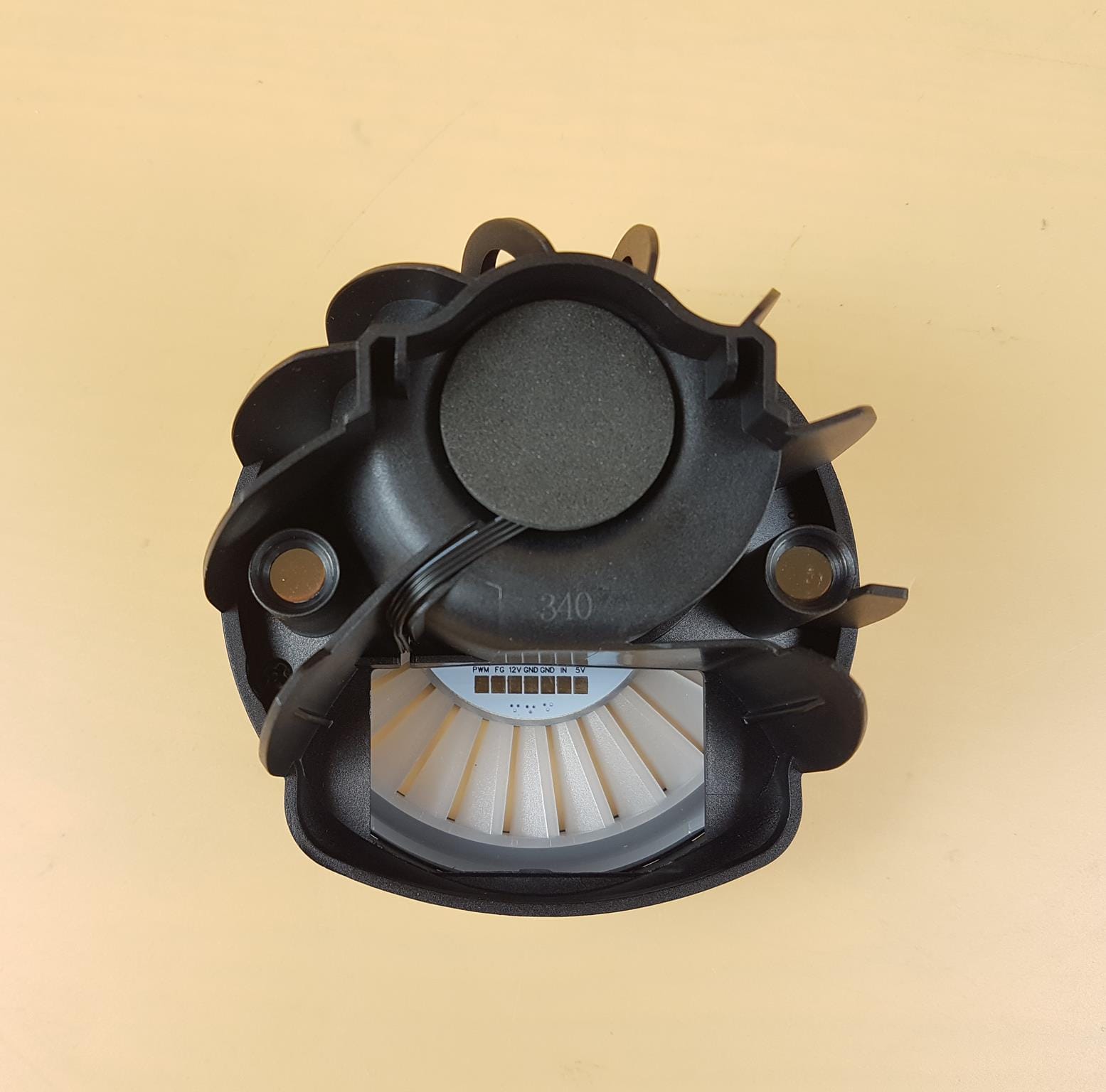
I am showing the base of the cover. Two pillars use magnetic attachment with the block. You can see 7 contact pads on the PCB right below the top. These make contact with the pins on the block.
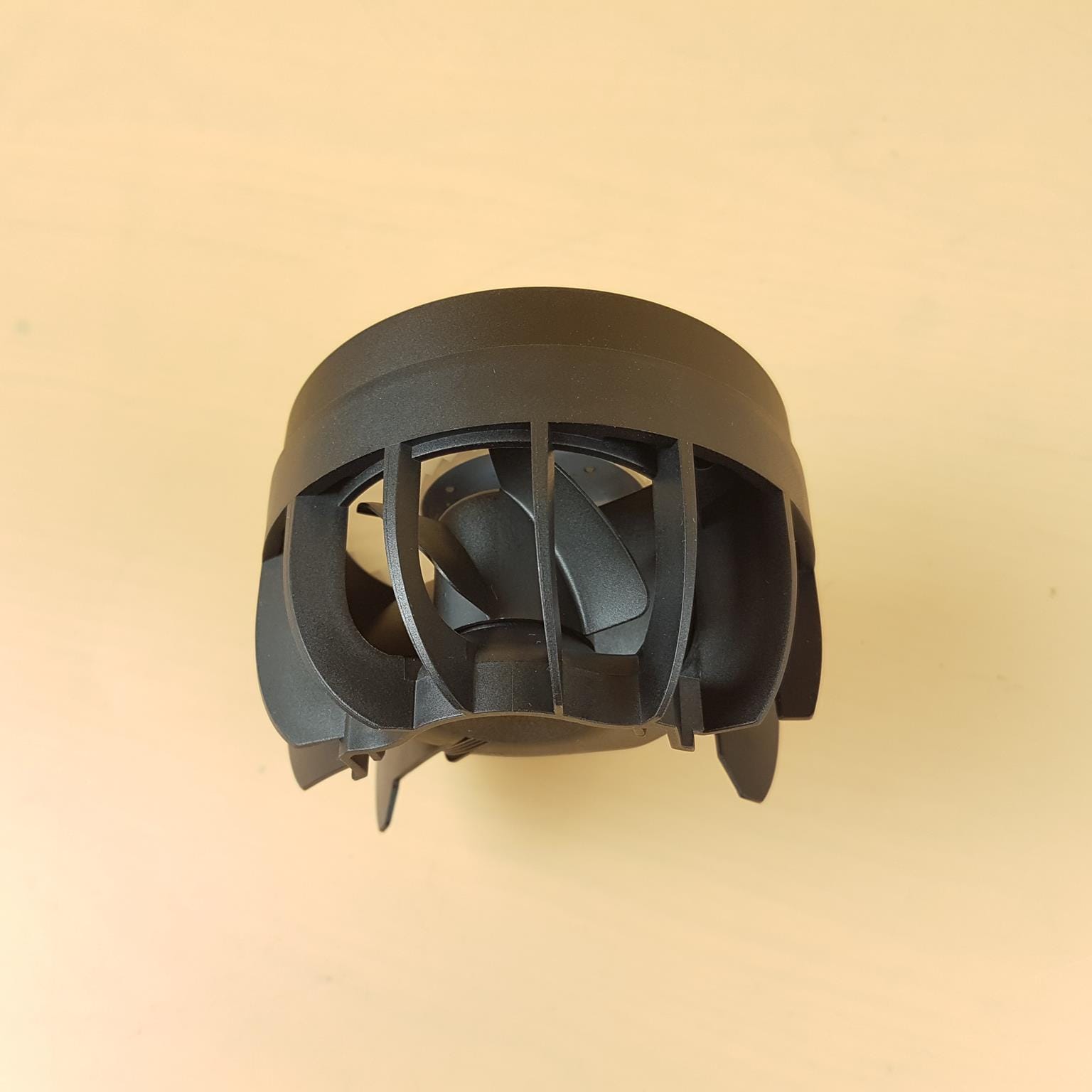
To ensure unrestricted airflow, there are large-size cutouts on the frame around the embedded fan. This fan blows air towards the near socket area of the motherboard.
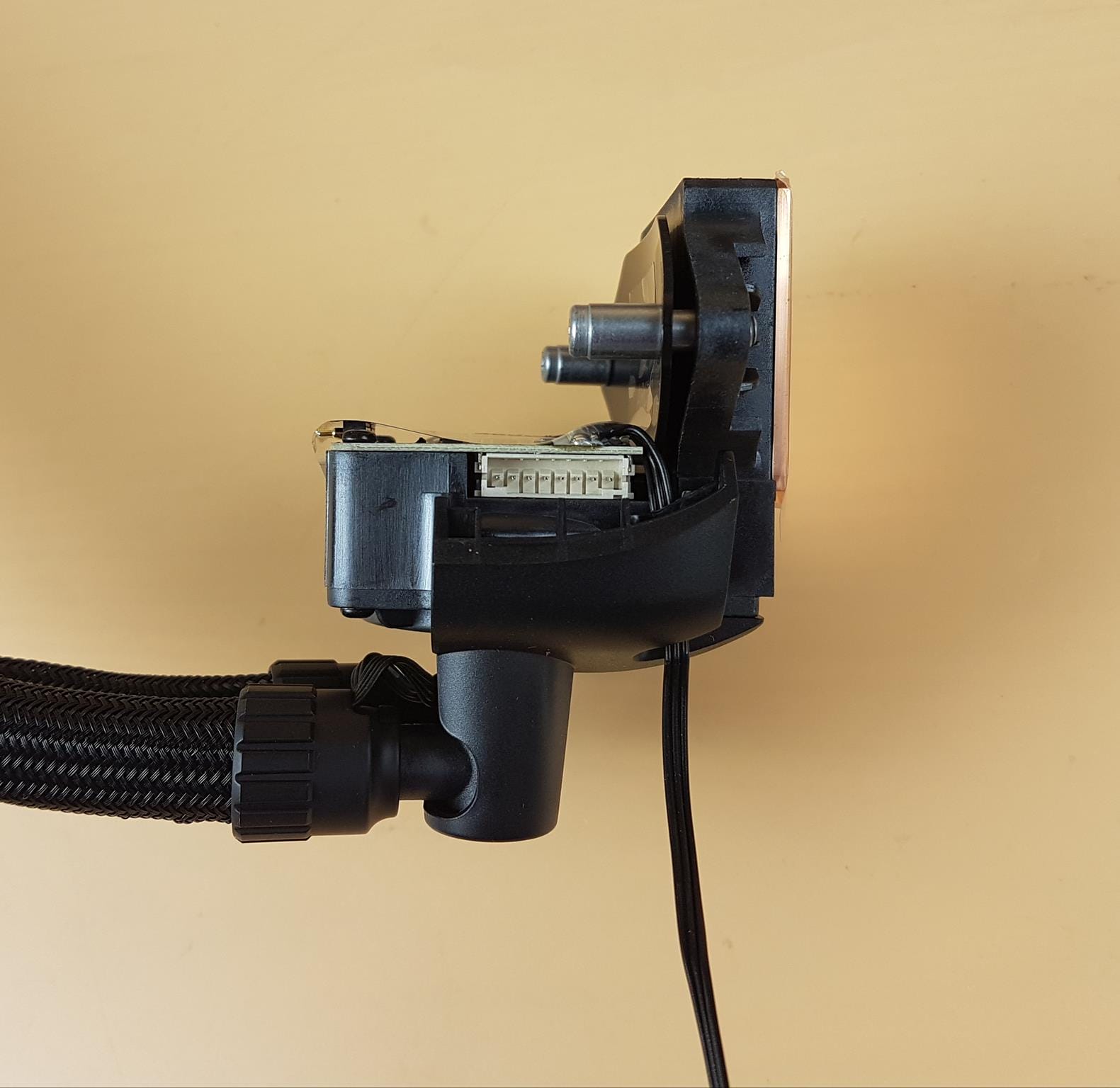
Now coming to the main area of interest which is the block itself, we can see a smart design that is in a right-angled design. There is a pump and propeller on the vertical side whereas the cold plate is on the base. Speaking of cold plates, ARCTIC has increased the fin density on the cold plate and optimized the coolant flow channels. The pump is rated for 800 to 2800 RPM using 0.35A at 12VDC.
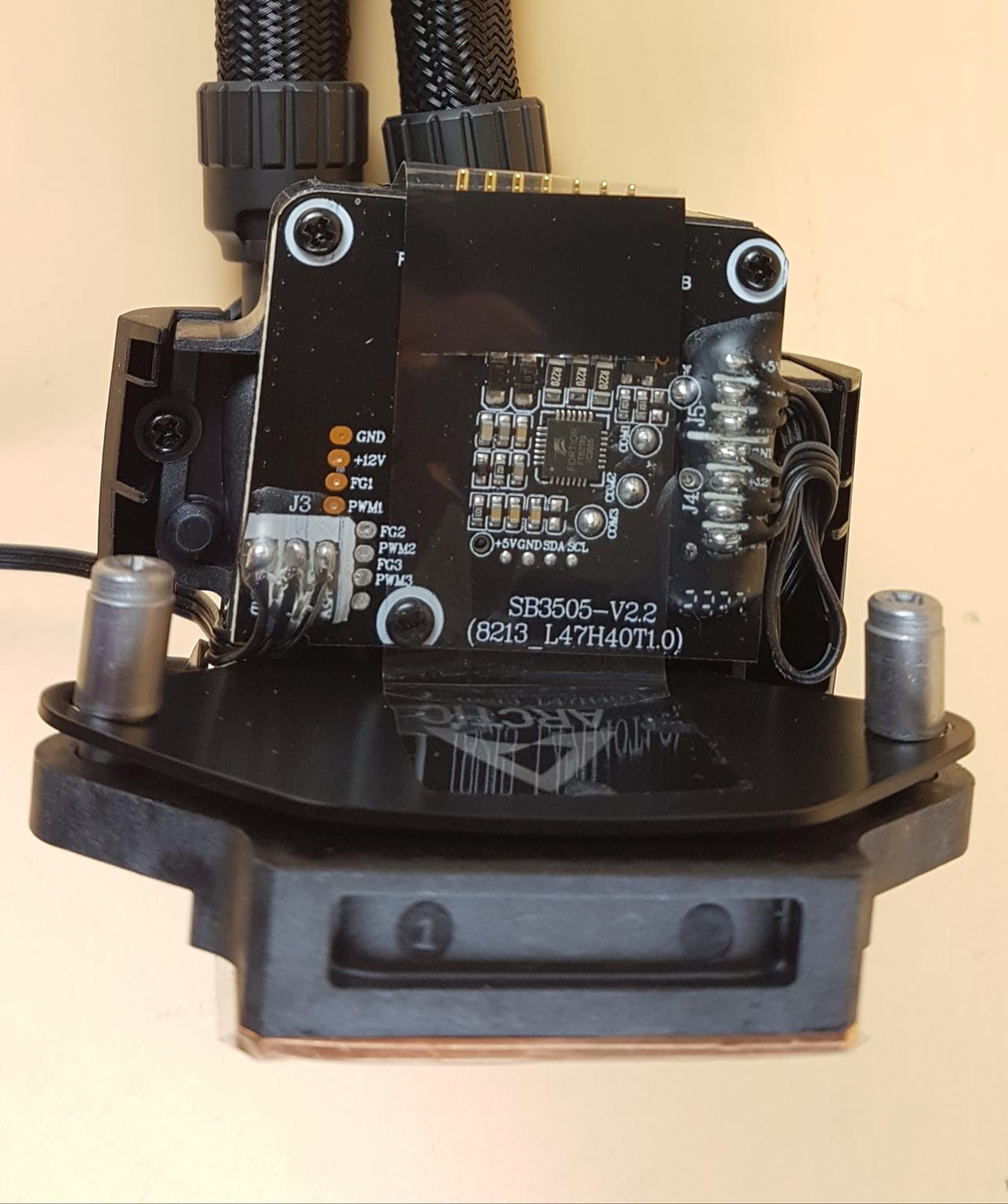
Now I am showing the PCB on the block which is also vertically mounted. 7 contact pins over the top connect to the pump cover. There is a soldered interface towards the right for the cables coming from the radiator. There is a 3-pin 5V standard ARGB connector cable coming out from the left side for which there is a 3-pin soldered interface.
ARCTIC has employed the ET8213Q controller which is a 3-phase sensor-less FOC controlled DC Brushless Motor drive IC with built-in Rdson 1 Ω drive MOS. The chip is highly integrated with the components required for motor control, requiring fewer peripheral components, low noise, and low motor torque ripple.
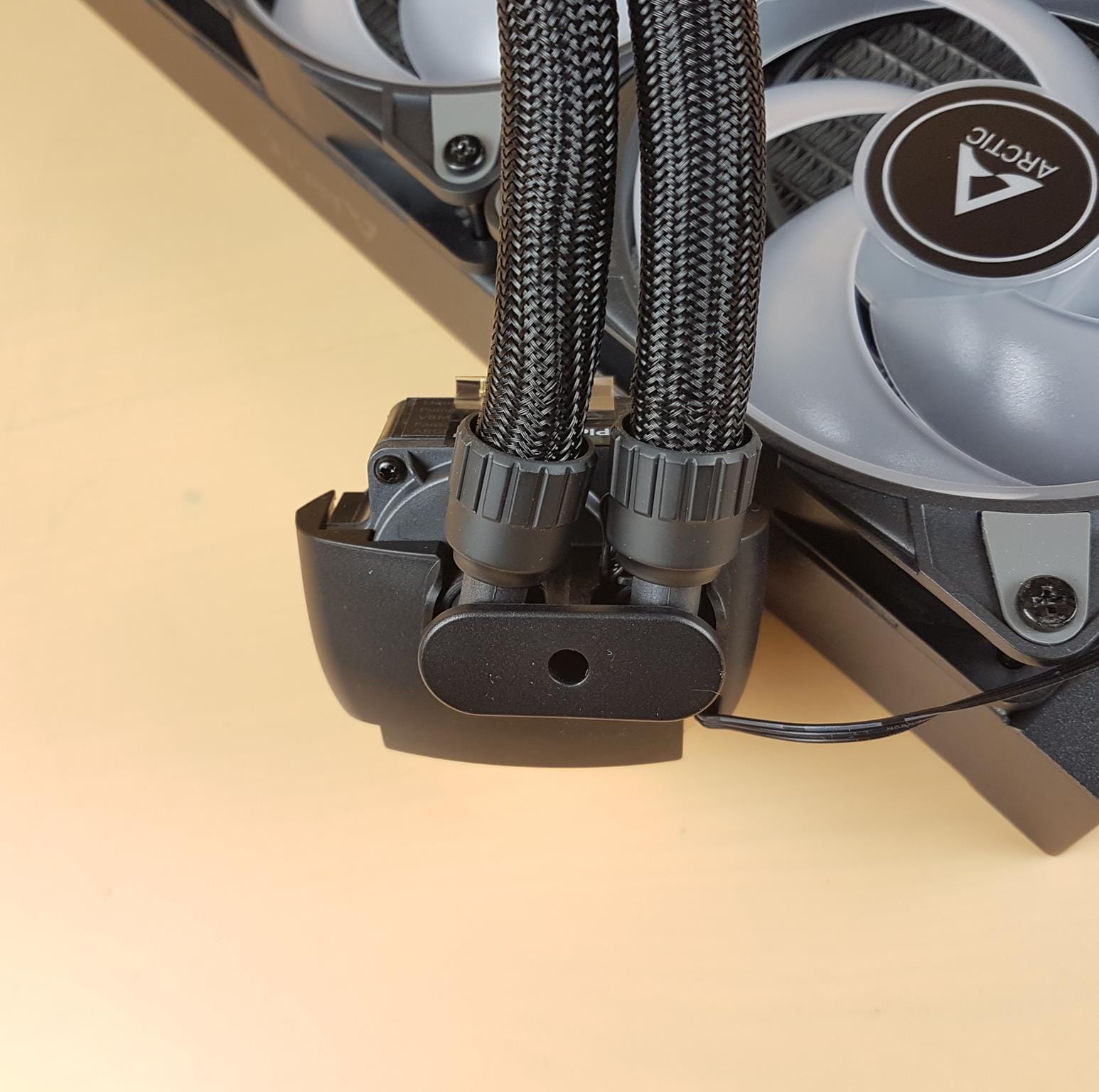
I am showing the backside of the housing. This housing encapsulates the rotary fittings and tube connection. The tubes can be slided within this housing only.
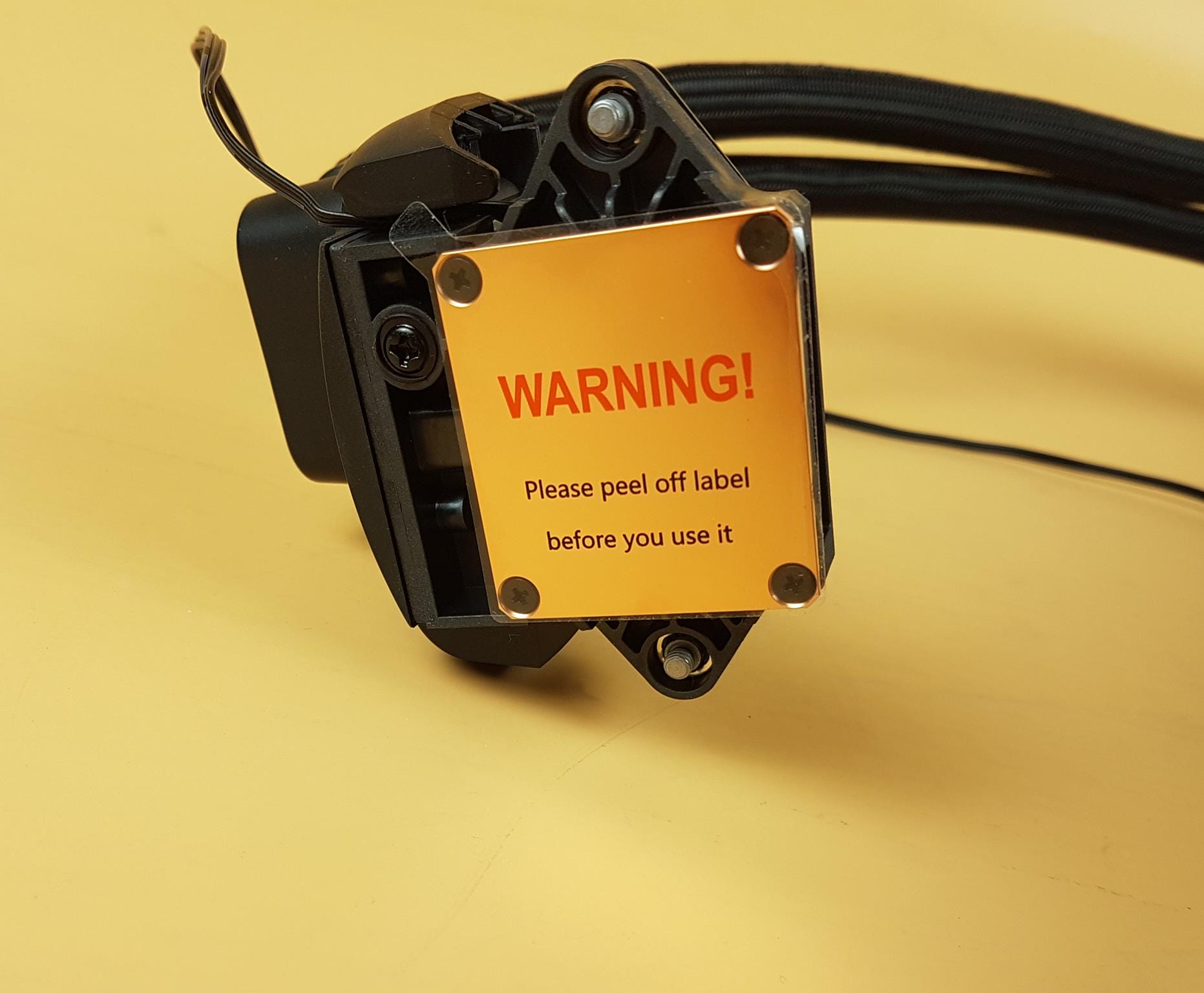
ARCTIC has used a copper base measuring 40x44mm which is the same size as on the LF-II coolers. But the internals of the cold plate are re-designed.
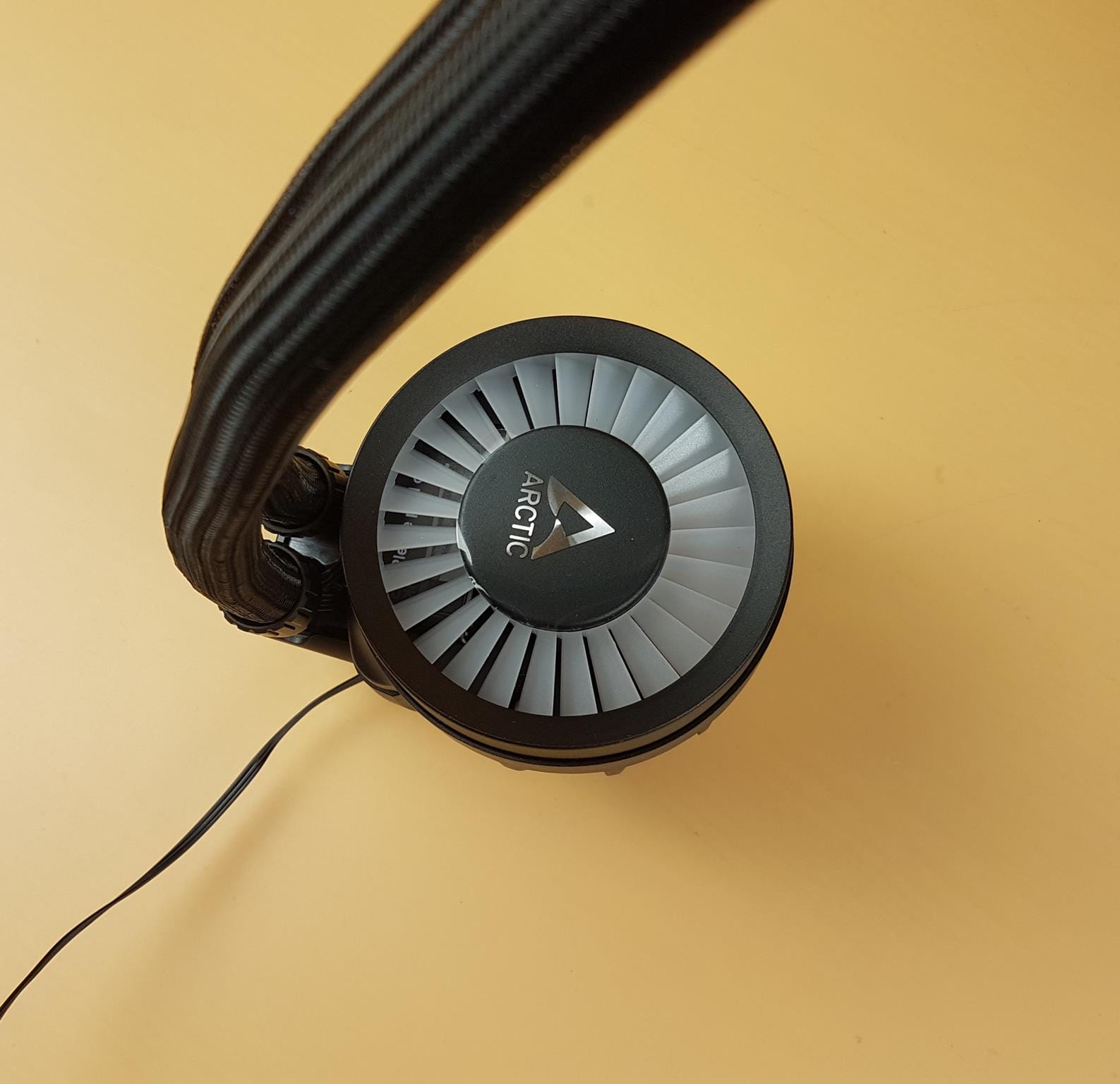
Place the pump cover over the block by aligning the pillars on the cover with the magnetic tips of the silver pillars on the block. You should hear a click indicating that the cover is fitted properly.
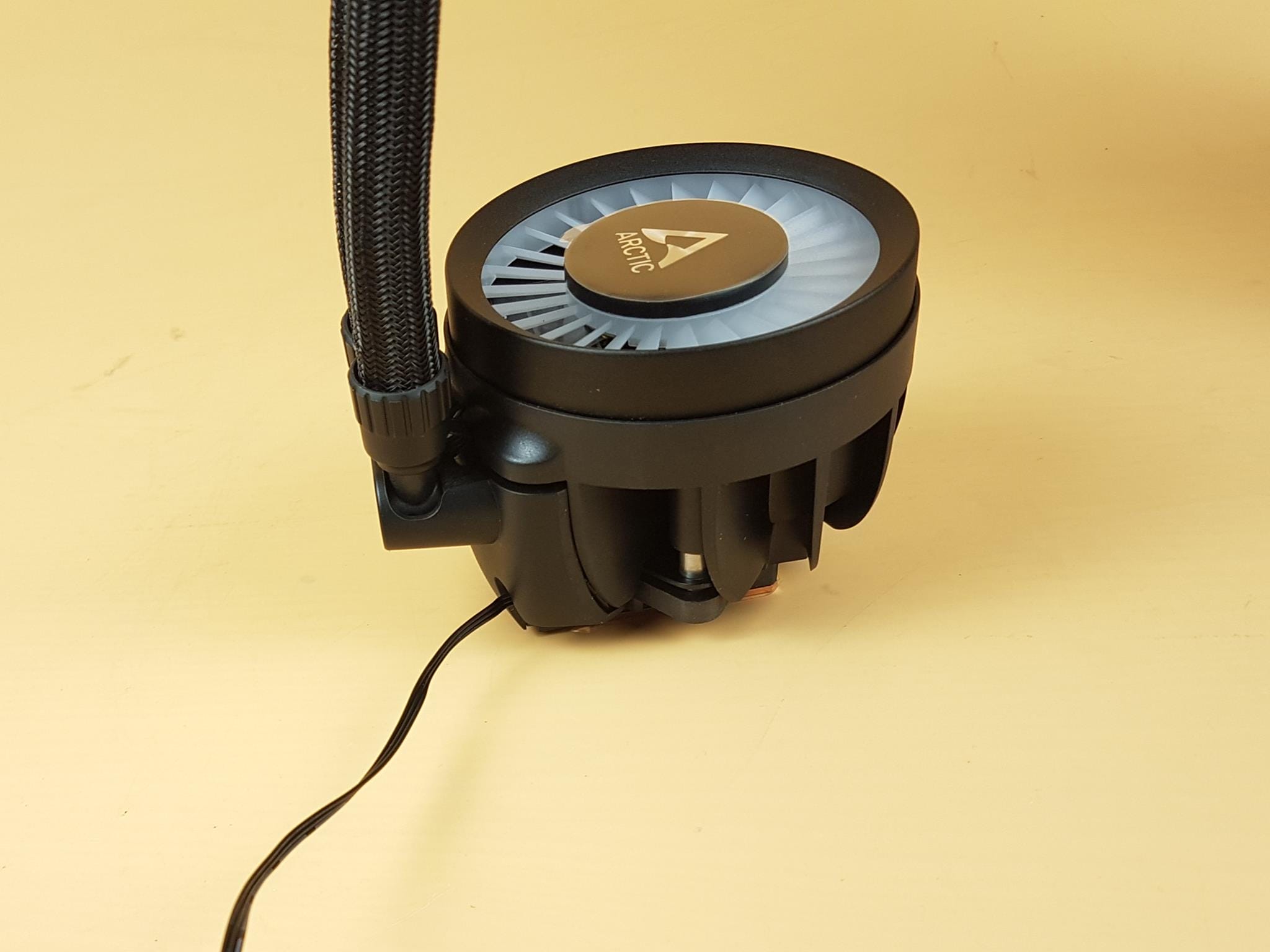
I am showing the side view of the fully assembled block.
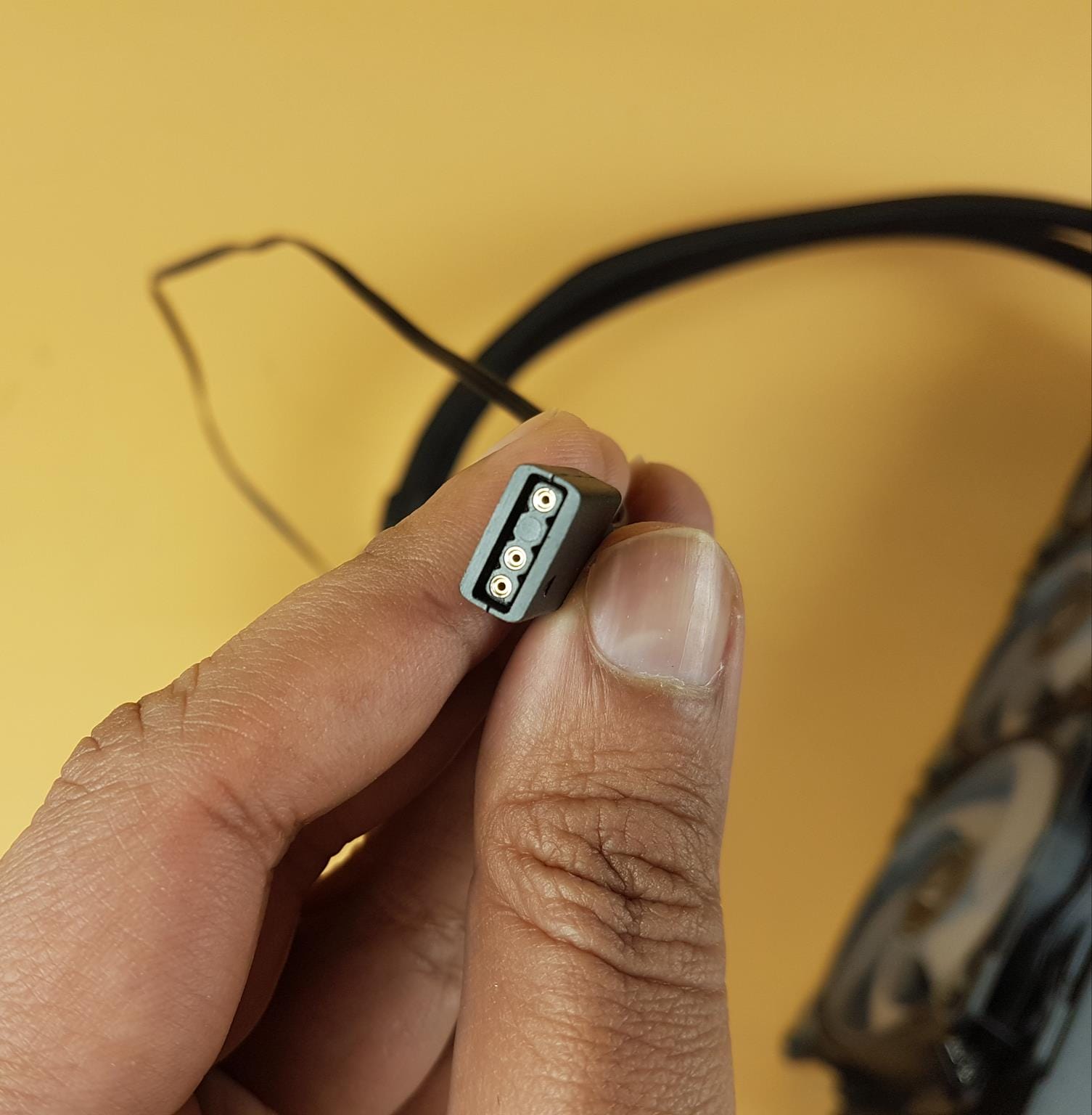
There is a 3-pin 5V, ARGB female connector cable that comes out of the block. This single cable will light up the entire unit since the cables are integrated.
FAN
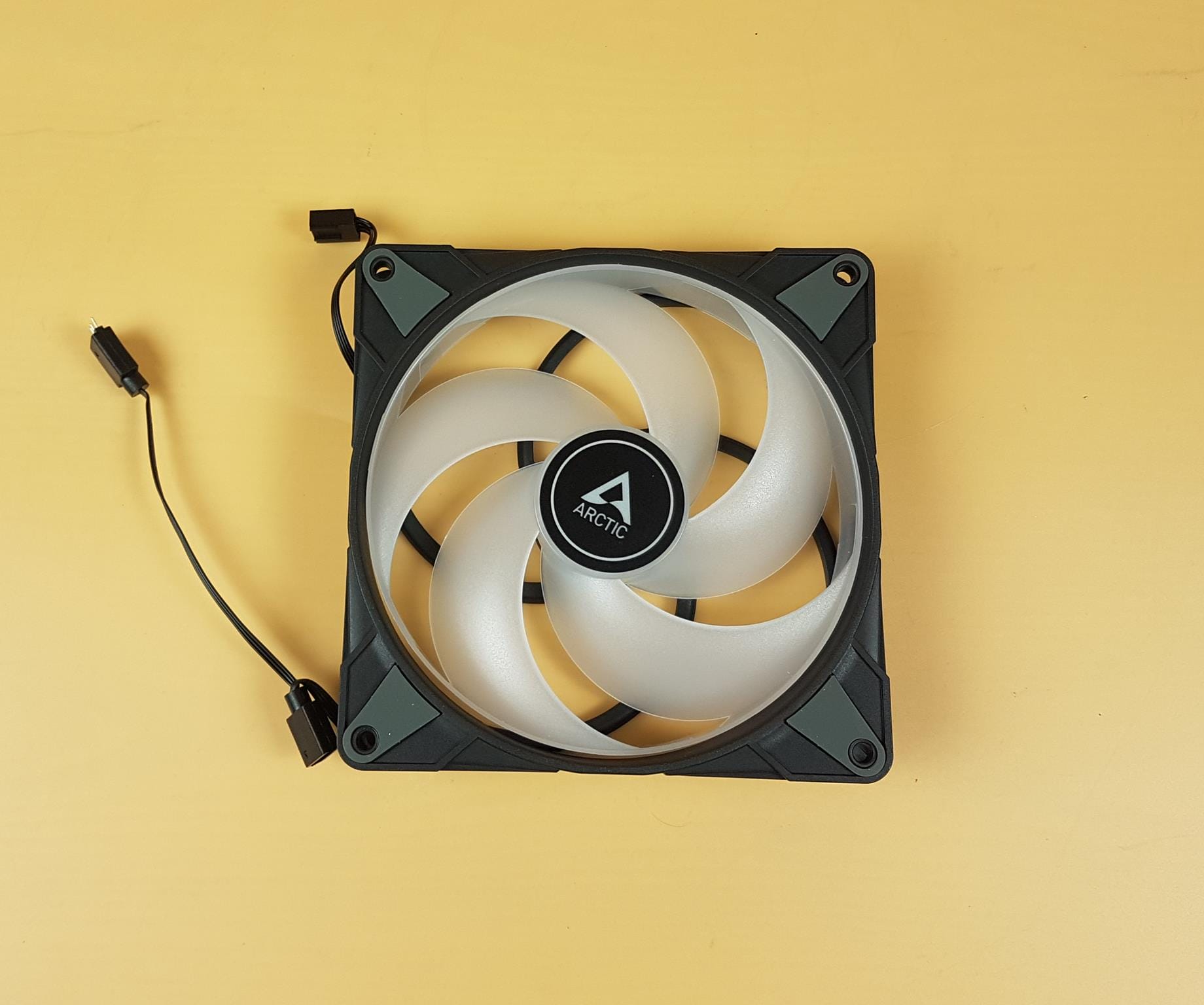
There are two P14 PWM PST ARGB Black edition fans provided with this cooler. These have the same design as P12 PWM PST ARGB fans. These have 5x translucent blades. There are gray color anti-vibration pads on the mounting corners. The complete fan assembly is connected to an outer circle that rotates with the blades.
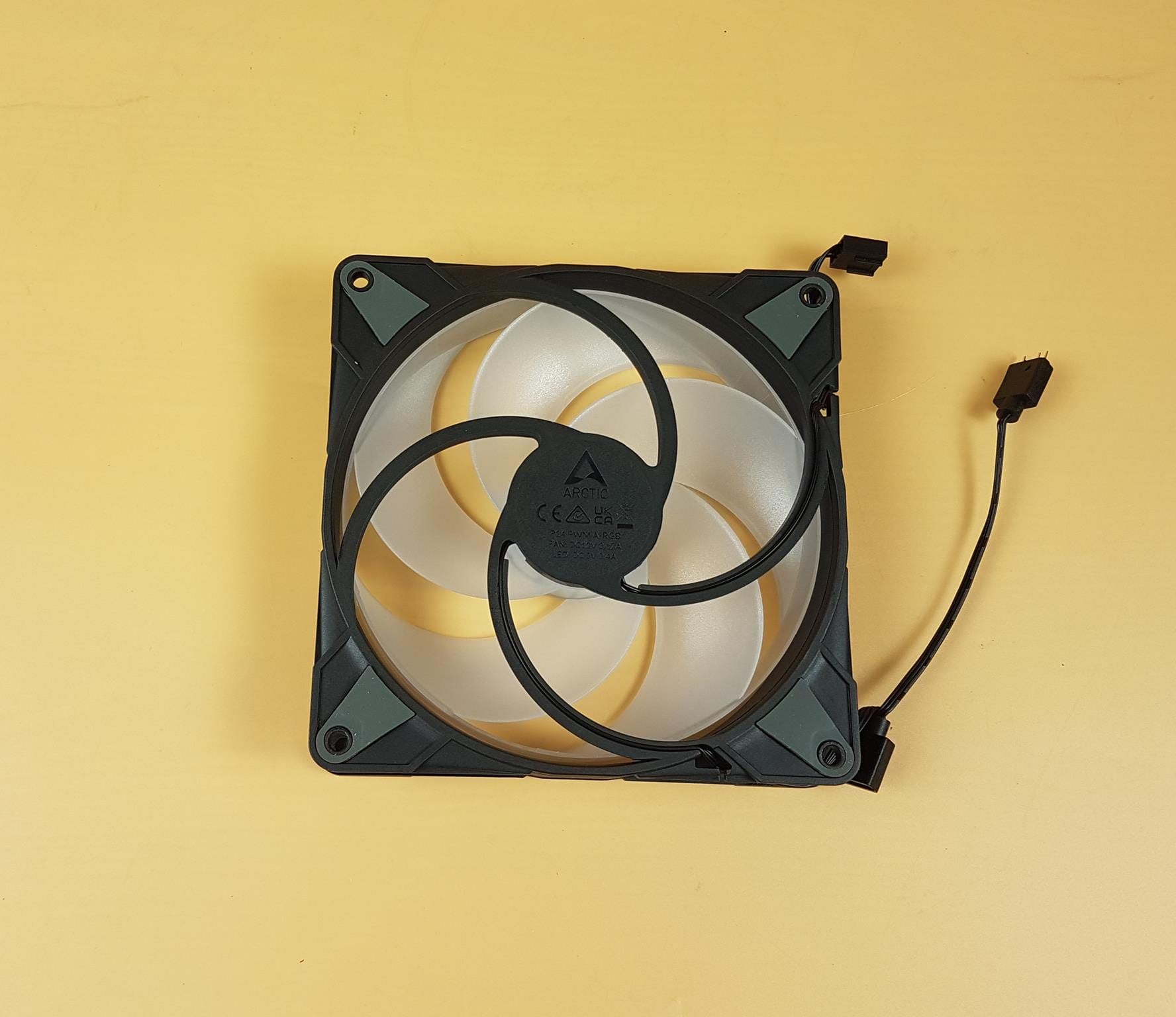
The backside of the fan shows a spiral-shaped 4x arms assembly holding the blade assembly with the frame. These would cut the air coming through the fans and would give a spiral flow though it is not a focused flow. The power rating of the fan is printed or embossed here as well.
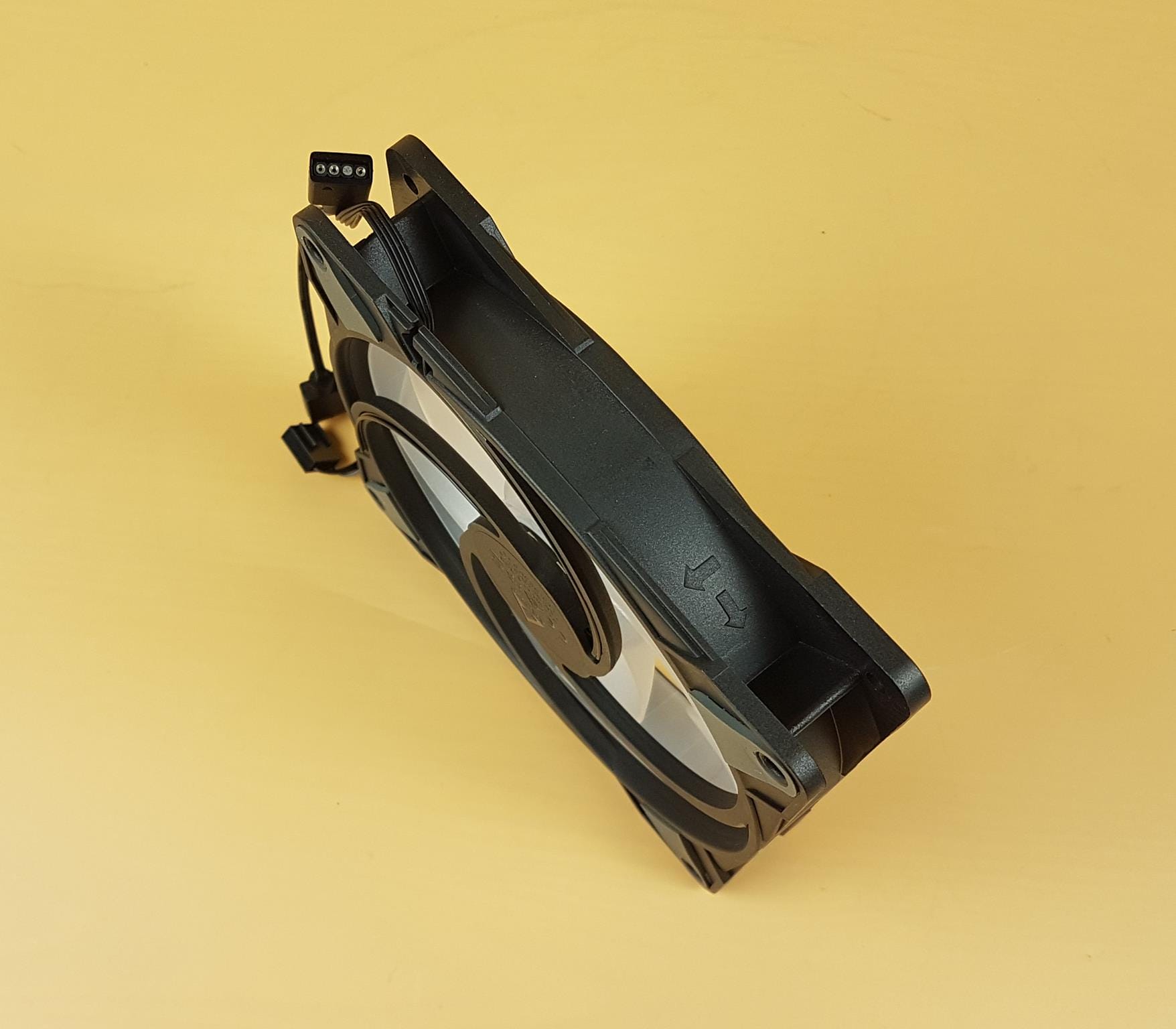
The arrow markers show the direction in which blades would spin and the direction of airflow through the fan.
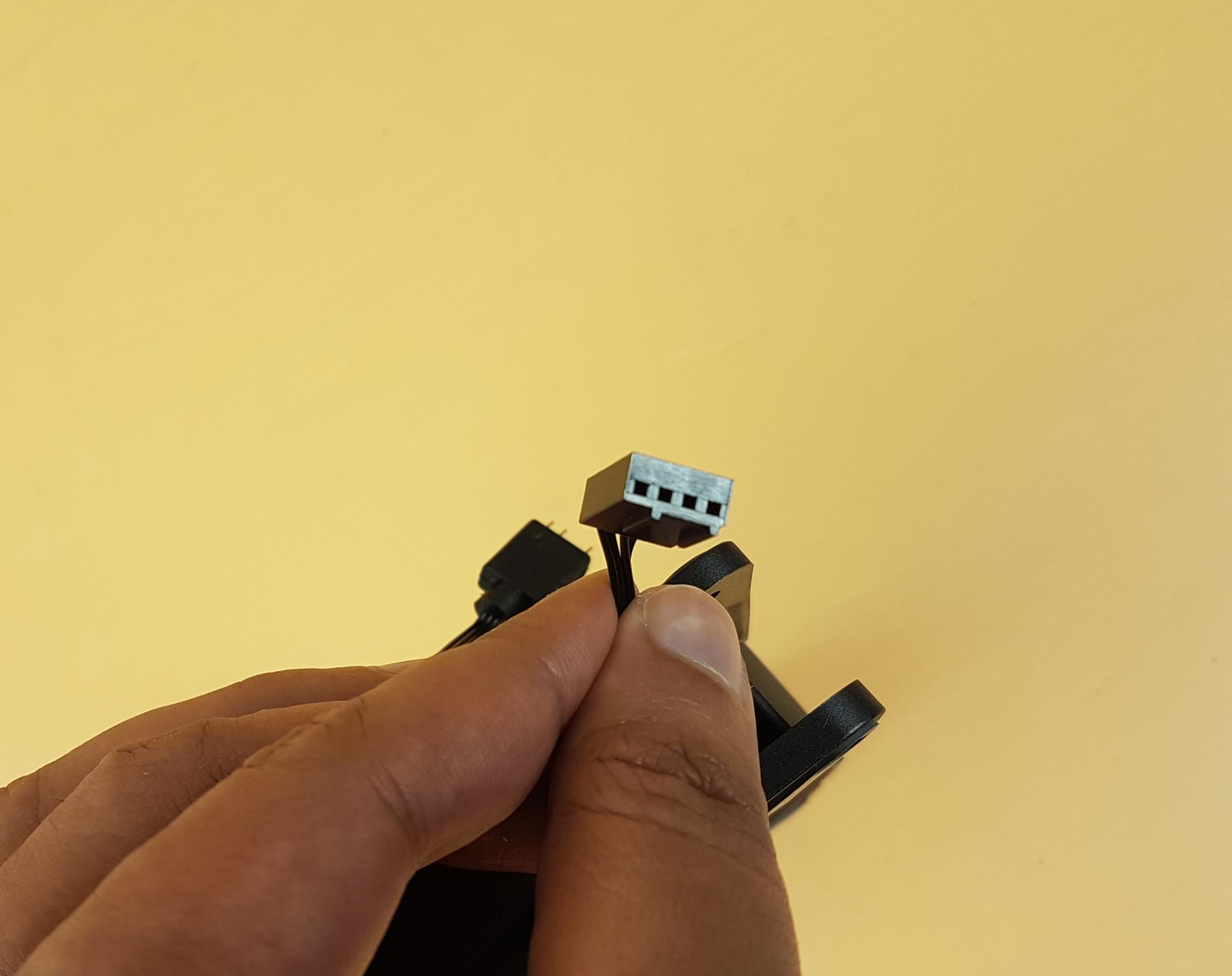
The fan is powered by a PWM connector cable.
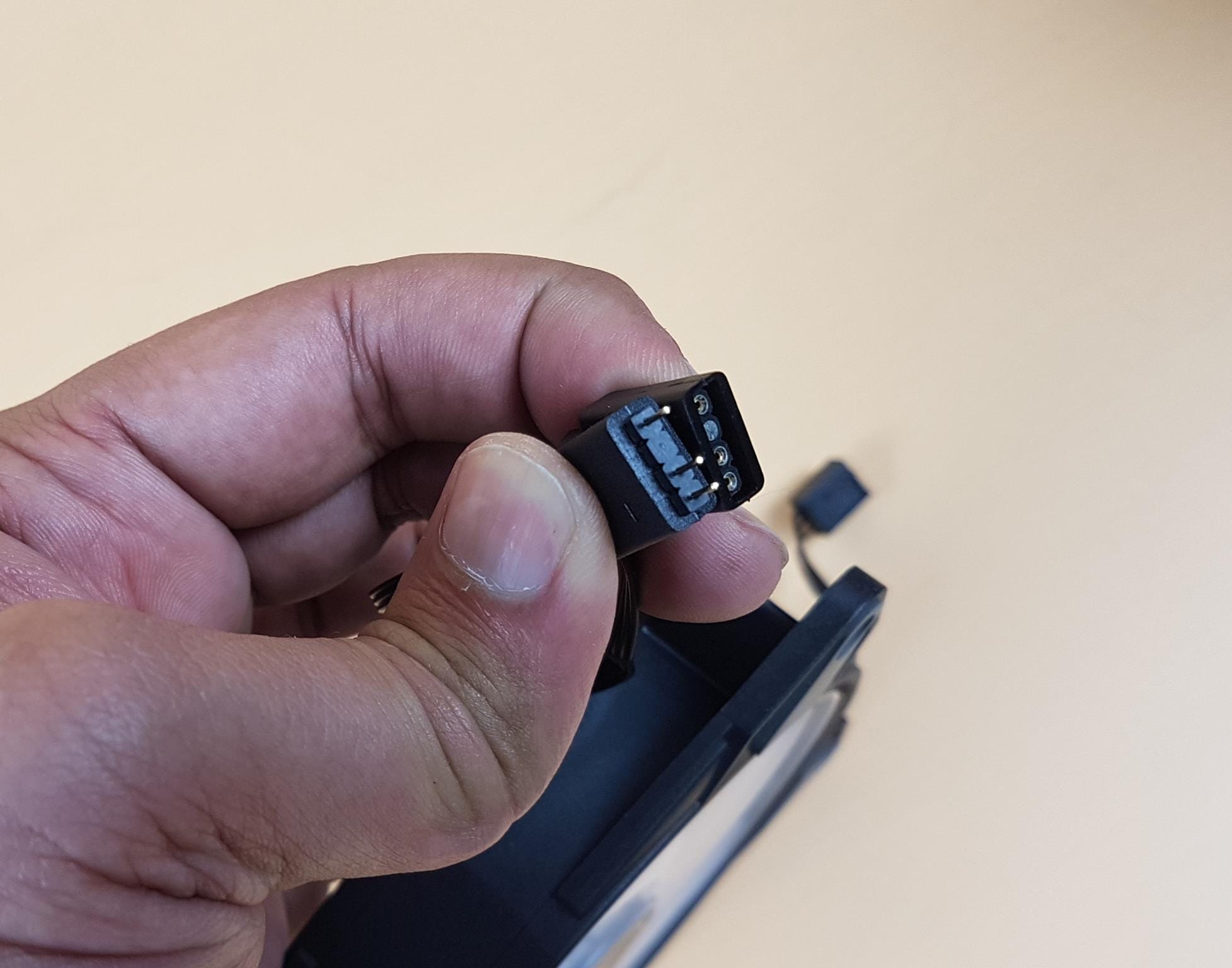
The ARGB LEDs are powered by 5V, 3-pin standard ARGB connector cables.
The specifications of the fans are:
| Dimension | 140x140x25mm |
| Type | 4-pin PWM Connector |
| Speed | 200~1900 RPM |
| Airflow | 69.90 CFM |
| Air Pressure | 2.0 mmH₂O |
| Bearing Type | Fluid Dynamic Bearing |
| Input Voltage | 12VDC |
| Input Current | 0.17A |
| LED Voltage | 5VDC |
| LED Current | 0.40A |
Installation
I am not covering the installation steps/process. Please refer to the user manual for that. But I would mention any observation during the installation. You would need to remove the Intel ILM to install the contact frame on the supported Intel sockets.
I have tested this cooler on the AMD AM5 platform on a GIGABYTE X670E AORUS MASTER motherboard just like the other two units. The observation recorded from that testing holds for this testing as well. The NVMe heatsink cover obstructed the block and I had to remove the NVMe heatsink cover to install this cooler. ARCTIC has mentioned that they would provide free-of-charge NVMe heatsink to the users so you are covered. Just run it with them. But keep in mind that this is a Gen5 port that needs an active cooling solution. Also, installing the block over the mounting bars is a bit tricky. You have to press down on the screws due to compression on the AMD socket.
ARGB Lighting
ARCITC is using standard connectors for the ARGB lighting. This makes the ARGB lighting compatible with the RGB Sync technology of various motherboard manufacturers. I have used the GIGABYTE RGB Fusion app and the lighting was working fine. Here are a few pictures:
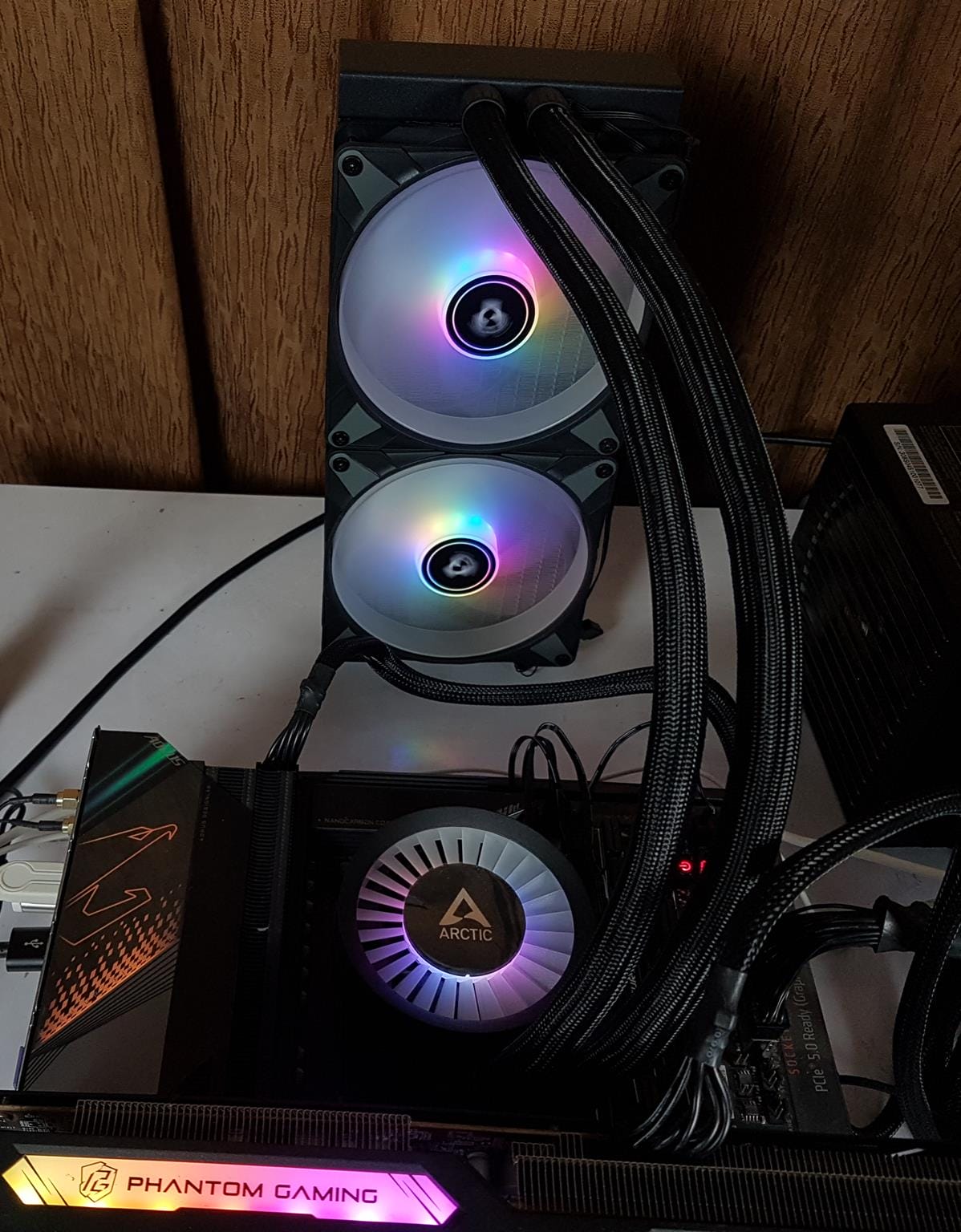
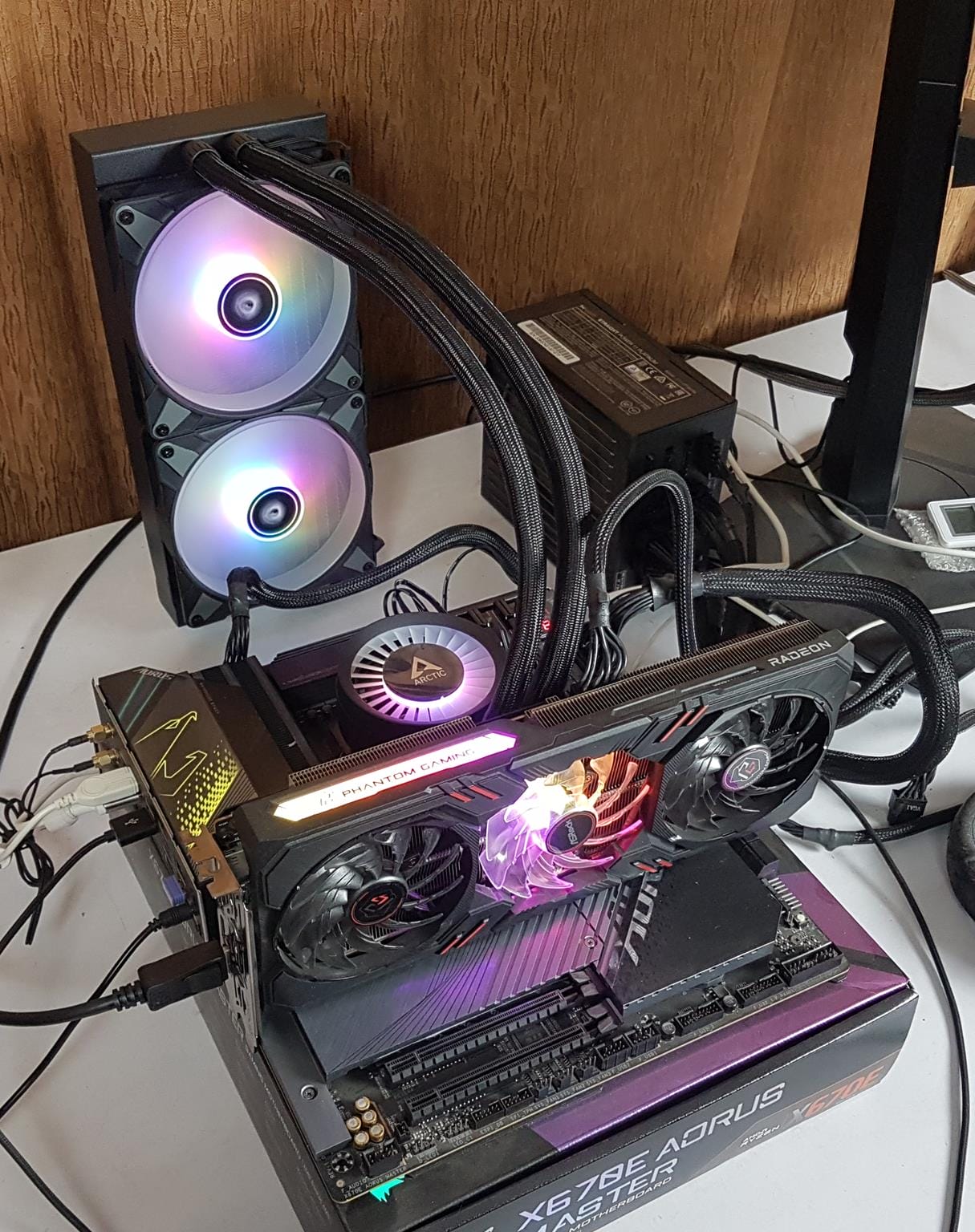
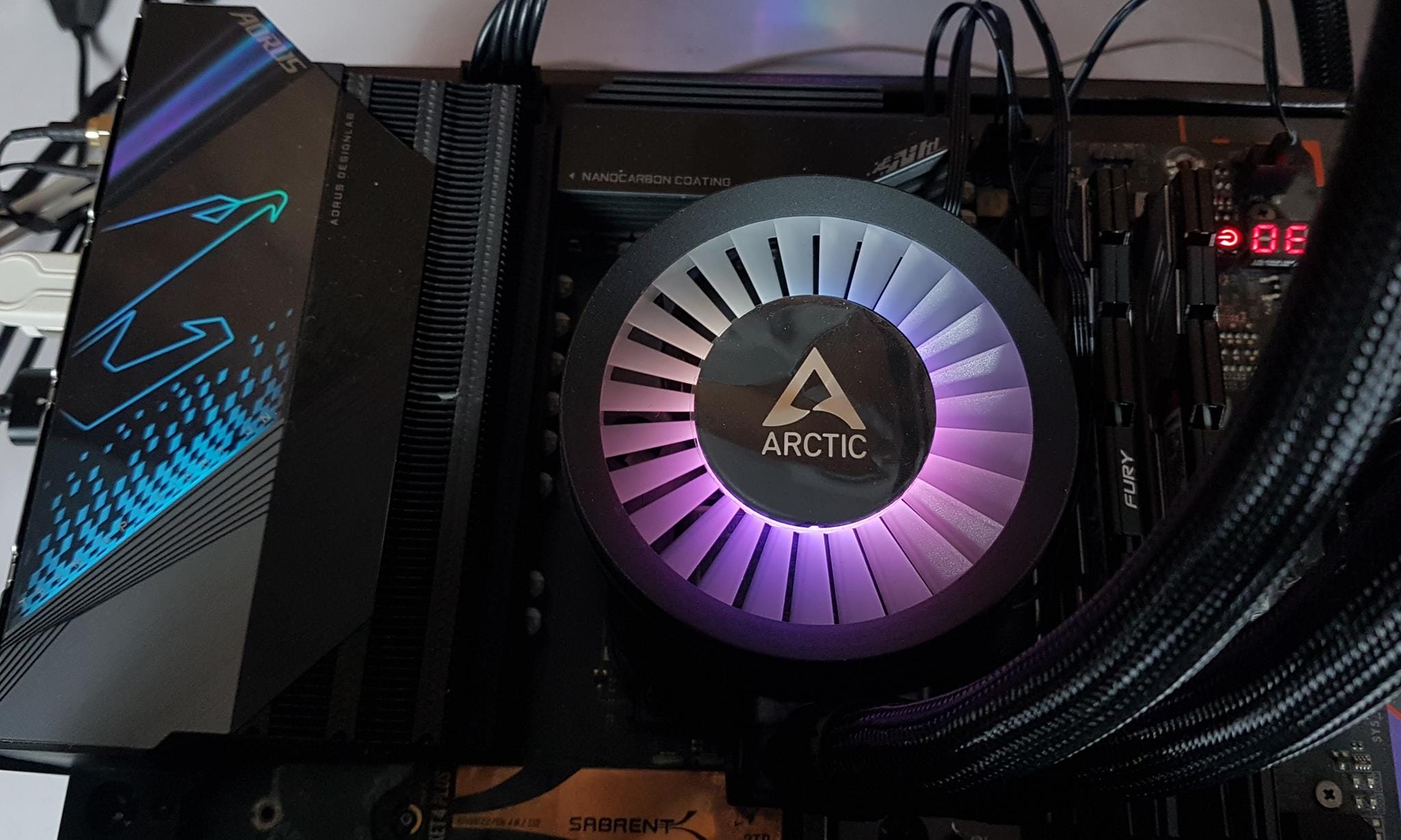
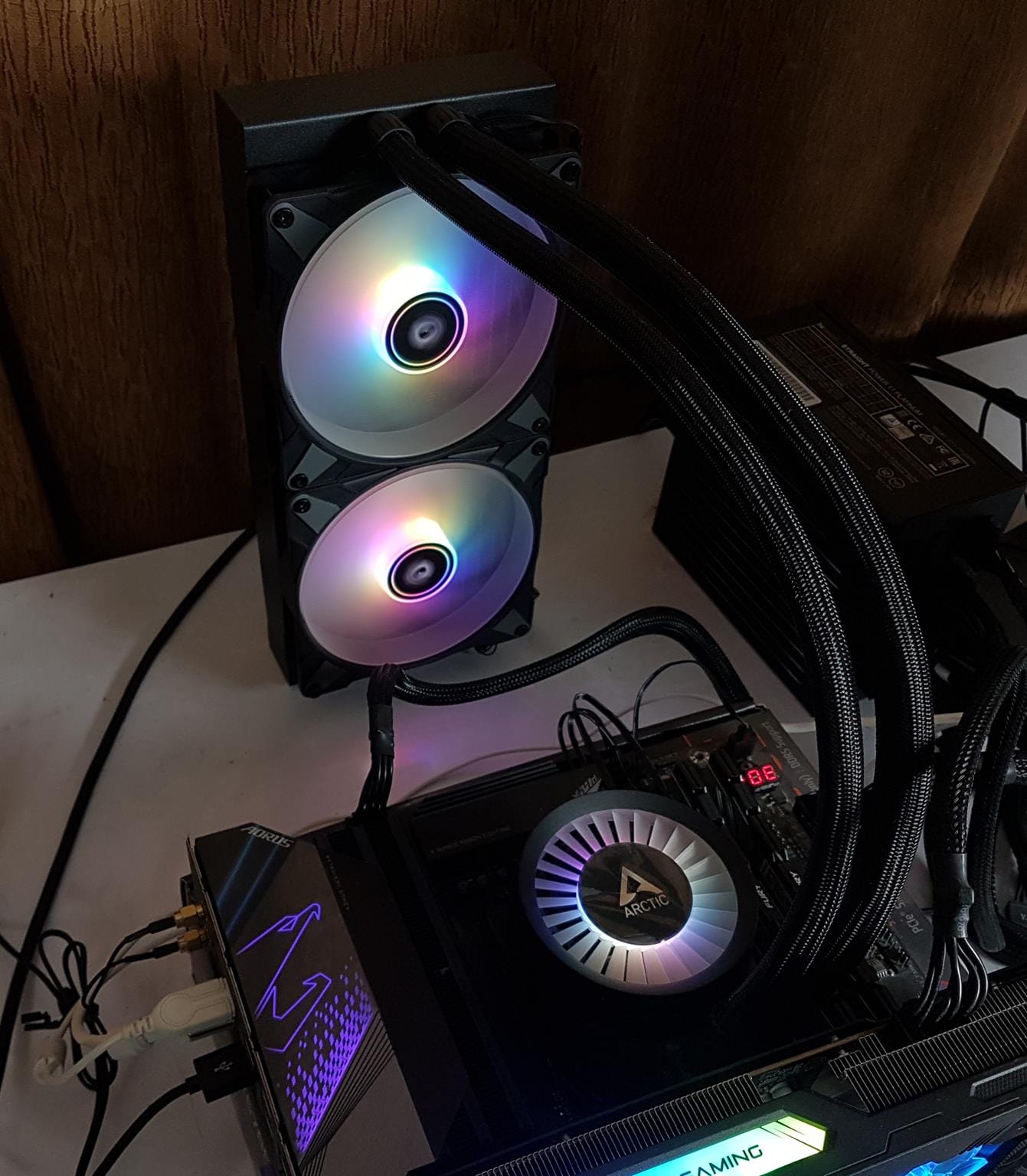
Testing
The following configuration is used for thermal testing:
- AMD Ryzen 7950X
- GIGABYTE X670E AORUS MASTER
- ARCTIC Liquid Freezer III – 360 ARGB Black
- Kingston Renegade Fury 32GB 6400MHz CL32 DDR5 kit
- ASRock Phantom Gaming RX 7600 Graphics Card for Display
- Sabrent Rocket 4 Plus 2TB NVME SSD
- Be Quiet! Straight Power 11 1000W PSU
- Open-Air Test Bench
Here is the settings table for testing:
| Clock (MHz) | Auto |
| Voltage (V) | Auto |
| PBO | Advanced |
| PPT | 200000mW |
| TDC | 480000 |
| EDC | 640000 |
| Boost Clock Override | +75Hz |
| Platform Thermal Throttle Limit | Auto |
| Thermal Paste | Noctua NT-H1 |
| Thermal Paste Application | Dots Method |
| Test Run Time | 30 minutes |
| Idling Time | 10 minutes |
| All Fans Speed | 100% PWM Duty Cycle |
| Pump Speed | |
| Stress Software | CINEBENCH R23.2 |
| Monitoring Software | HWINFO64 |
We are reporting delta temperature in the graph because room temperature varied from 20.9°C to 22.8°C throughout the day. The testing is done on an open-air bench system. Once inside the chassis, the temperatures are expected to rise and would largely depend upon the optimal airflow inside the chassis.
Not every run of the stress test may yield the same result. This could well be due to many factors like mounting pressure, thermal paste application, and varying ambient temperature. Not to mention the silicon differences even among the same category of the chips. Hence, it is pertinent to mention the testing methodology along with the specifics.
Result

My main test was with a socket power of 200W (resulting package power of 205W). The ARCTIC LF-III 280 ARGB Black was producing roughly 40.1 dBA sound level.
The Liquid Freezer III 280 ARGB Black has a good lead over the other coolers in the graph. This is an expected performance of 280mm since the other coolers in the graph are 240mm.
Conclusion
After testing Liquid Freezer III 240 and 360 coolers, I have taken a spin at Liquid Freezer III 280 Black ARGB cooler. This cooler has the same footprint as on the other two tested units with the difference coming from the size and 140mm fans.
This unit is also supplied with two P14 PWM PST ARGB fans pre-installed over the radiator. ARCTIC has done integrated cable management from the factory. All that you need to do is install the cooler, decide on the cable, and call it a day.
The black aluminum-made radiator has a dimension of 317x138x38mm (LxWxH). With installed fans, the overall height is 65.5mm. The FPI count is 15 and the channel count is 14. The rubber tubes have black sleeves and ID/OD rating is 6.0/12.4mm. The splitter cables are passed under the mesh sleeve for a neat look.
ARCTIC has provided two cables. One cable has a single PWM connector that allows a single source control for all the fans and the pump. just like Liquid Freezer – II coolers. However, there is another cable those 3 x PWM connectors that would allow you to control the VRM fan, radiator fans, and the pump individually.
Speaking of the fans, 2x P14 PWM PST A-RGB fans use Fluid Dynamic Bearings are rated for up to 19000 RPM, and feature an auto-stop function. They can produce a total airflow of 69.90 CFM with a static pressure of 2.0mmH₂O. The noise level and MTTF rating are not mentioned. Each fan has a 4-pin PWM connector as well as dual 3-pin 5V ARGB connectors.
I appreciate ARCTIC for using standard connectors. However, the internal header on the block is not standard. The bundled fan cables use a proprietary connector for that header. I can’t complain much about it since the power delivery and control mechanism on the block may have this design requirement.
The block and VRM fans have been uplifted. There is a removable pump cover that has a 60mm embedded fan for the VRM cooling. There are 12x ARGB LEDs as well on the cover for illumination over the top. The fan draws fresh air from the top where there are guided vanes and flows the air towards the near socket area of the motherboard. The VRM fan is rated for up to 2500 RPM.
The block has a smart design which is in right angled layout. The main PCB is exposed on the vertical side and it shows that ARCTIC has used the ET8213Q controller which is a 3-phase sensor-less FOC-controlled DC Brushless Motor drive IC. The PCB has 7-pin contact pins on the top that make contact with the pads on the pump cover. There is a fan header integrated into the PCB to which the bundled fan cable(s) is to be connected. ARCTIC has improved the cold plate design and has provided a dense fin stack with improved coolant flow channels. The pump is rated for up to 2800 RPM.
Now coming to the installation part of this cooler, this cooler is compatible with AM4/AM5 sockets on the AMD camp. The total number of items required to install mounting brackets for this socket is 10 in 4 steps. You would need to press on the screws to lock them in the standoff. This is due to the compression on the socket.
On the Intel, side you can use this cooler only on LGA1700/1851 sockets which is because you would need to remove the ILM to install the contact frame for these sockets. ARCTIC could still have provided standard Intel mounting by making contact frame mounting optional in my opinion. This would have made this cooler compatible with other Intel sockets as well besides probably voiding a warranty of the motherboard if the user is not careful enough not to damage the motherboard and does not misplace the stock ILM.
ARCTIC has given a massive discount till May 2024 on the new coolers. The MSRP of LF-III 280 ARGB Black is €123.99. However, it is retailing at €81.83. It is a perfect time to grab these coolers while the price is down.
The thermal performance of this cooler is quite well. It is silent and outperforms the Liquid Freezer II and Liquid Freezer III 240 coolers. This cooler has won our Recommended Award.
Pros:
- Good Thermal Performance
- 60mm VRM Fan
- Removable Top Cover
- Integrated Cable Management
- Ability to control all fans and pump individually
- Ability to control all fans and pump using a single cable
- Pre-Installed Fans
- Compatible with Intel LGA1700/1851 sockets
- Compatible with AMD AM4/AM5 sockets
- Improved Cold Plate and pump design
- Easy Installation
- Excellent Noise Output
- 6-Year Warranty
- Price
Cons:
- Intel Contact Frame should be optional
- ARCTIC branding is fixed on the pump cover
- Motherboard Compatibility
- Tight Fitting on AM5 due to compression


















